Abstract
This review provides in-depth coverage of numerous mechanisms available for the etherification process of glycerol, including alcohol solvent, olefin solvent and solvent-free routes along with products that are formed at various stages of the reaction. Mono tert-butyl glycerol ether (MTBG), di tert-butyl glycerol ether (DTBG), and tri tert-butyl glycerol ether (TTBG) are the three general ether compounds obtained through tert-butyl alcohol (TBA) etherification. Glycerol etherification with n-butanol results in the formation of glycerol ether products that are linked to the substituted butyl groups. These products include two mono-butyl glycerol ethers, two di-butyl glycerol ethers and a tri-butyl glycerol ether. Two mono-benzyl glycerol ether isomers, two di-benzyl glycerol ether isomers and tri-benzyl glycerol ether are the most reported results when benzyl alcohol is used as a solvent in the etherification reaction. The etherification of glycerol with 1-butene involves a series of equilibrium reactions to produce mono-ethers, di-ethers, and tri-ethers, whereas the etherification of glycerol with isobutene is carried out via tert-butylation of glycerol, yielding similar glycerol ether products when TBA is used as a solvent. As the by-product may be easily removed, the solvent-free glycerol etherification approach may have several advantages over the other conventional methods. Therefore, further studies on base-catalyzed glycerol etherification that employs a solvent-free reaction route may reveal a method for improving the conversion, selectivity, and yield of reaction products. This review study is crucial in improving knowledge of numerous mechanisms and how they relate to the effectiveness of the product’s catalytic process.
1. Introduction
The exponential growth in the population and the rapid economic development of individual nations have driven the higher generation and usage of global energy. Since fossil fuels are considerably cheaper to be produced compared to renewable energy supplies, the energy infrastructure heavily relies on them as the feedstock. However, in meeting the needs of global energy, non-renewable fossil fuels could bring negative impacts on the global economy due to their depletion of reserves which has driven up the price of petrochemical products, accelerated climate change and other environmental issues. As a result, the world market has developed an interest in alternative resources such as biofuels due to their renewable nature. Biomass conversion to fuel and fine chemicals remains a potential option. Biofuels such as biodiesel are frequently recommended as an alternative resource because they are renewable, environmentally friendly, biodegradable, and less expensive to be produced in the long run [1,2,3]. Glycerol, which is a key by-product of biodiesel synthesis, has significant potential as a building block for high-value compounds, including glycerol ethers, 1,2-propanediol, 1,3-propanediol and glyceric acid [4,5]. The possibility of using biofuels as an alternative fuel for diesel engines has grown significantly during the last decade. At the same time, these techniques increased the crude glycerol output. Glycerol is manufactured from the by-product of the conversion of raw triglycerides into biodiesel with around 100 kg of glycerol being produced for every ton of biodiesel produced [5,6,7]. Glycerol production is inextricably related to biodiesel generation which has been the dominant source since 2003, accounting for 62% of the global glycerol supply in 2018. As a result, the key supply driver of biodiesel production must be factored into the market analysis of glycerol production. Between the years 2006 and 2019, global glycerol output increased from 1.7 million to 3.7 million metric tons [7]. In 2020, the value of the worldwide glycerol market was USD 1.68 billion. In the year 2020, the worldwide market expanded by 5.8%. Starting from the year 2021 to 2028, it was anticipated that there will be an increase from USD 1.76 billion to USD 2.53 billion in the market with a compound annual growth rate (CAGR) of 5.3%. This is due to the rising demand from the food, pharmaceutical and nutraceutical industries [8]. The condensation reaction between glycerol and other alcohols can produce glycerol ethers, which may improve the combustion qualities of gasoline. As a result, it is also termed a green fuel additive [9]. The rise in the generation of oleochemicals and biodiesel has led to the growth in glycerol production and caused surplus glycerol in the market. The price of glycerol has decreased due to its glut supply as a result of the major advancement in the manufacturing of biodiesel, thus making it a practical chemical for creating other value-added chemicals [10]. According to market data from 2003 to 2017, the crude glycerol price had decreased significantly due to an oversupply of glycerol with projections up to the year 2020 as shown in Figure 1 [11].
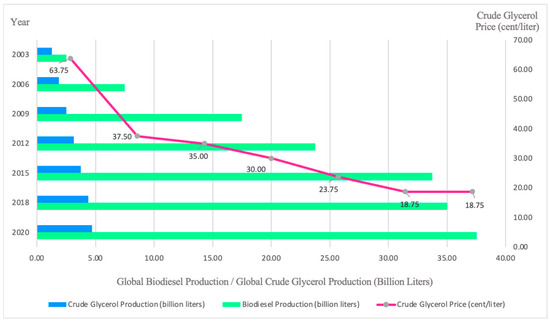
Figure 1.
Global biodiesel production and crude glycerol price [11].
Since glycerol is a non-toxic, biodegradable, and edible substance, it can be an important raw ingredient for synthesizing value-added compounds [6,12]. Catalytic techniques such as etherification [13], dehydration [14], reforming [15], oxidation [16] and esterification [17] have been applied for the conversion of glycerol. Many researchers are interested in the etherification reaction because the mixture of tert-butyl ethers of glycerol, particularly di-ethers and tri-ethers, can be employed as biodiesel additives because they can promote cleaner combustion in internal combustion engines [18]. These ethers minimize particulate matter, carbon monoxide, hydrocarbons and aldehyde emissions while lowering the viscosity of biodiesel. Glycerides, which are lipids with a glycerol backbone, contain the glycerol backbone. Glycerol is divided into four categories, namely grade, source, application, and geography. Figure 2 depicts the application sectors of the worldwide glycerol market. Glycerol is used to grant the smoothness and lubrication properties to a variety of personal care and cosmetics items, which include toothpaste, soaps, shaving creams as well as skin and hair products. The personal care and cosmetics industries have been expanding at a rapid pace around the world due to the rise in hygiene awareness, increased demand for sector products and the rise in female employment. During the COVID-19 pandemic, the demand for glycerol in soaps, hand wash and detergents soared, particularly from the personal care business [7].
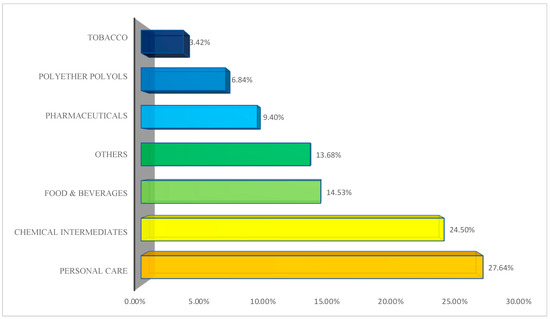
Figure 2.
Global glycerin market share by application in 2020 [8].
Glycerol is an ideal chemical product since it can be used to create di-, tri-, tetra- or polyglycerols, thus increasing the yield of the biodiesel production process. Glycerol molecules condense during the etherification process in order to generate di-glycerol and tri-glycerol, which can have a linear, branching or cyclic shape. The final form of the molecule is determined by whether condensation occurs at the primary or secondary hydroxyls. Intramolecular condensation can potentially impact the ultimate structure of the product. Continuing the process will cause polyglycerols to have greater molecular weight, which is undesirable [7,18]. Research works are still ongoing to improve the yields for lower-degree polyglycerols such as di- and tri-glycerol. As a result, developing a suitable catalyst with exceptional characteristics that can achieve high glycerol conversion while simultaneously providing higher levels of desired polyglycerols such as di and tri-glycerol has remained a major scientific issue. Recent advancement in the field of glycerol etherification has focused on improving the yield and conversion of polyglycerols and glycerol ethers using both solvent-free and solvent-based methods. These include the use of heterogeneous base catalysts [13], acid catalysts [19], heteropolyacids-catalyzed reactions [20], alcohol solvents [19,20,21,22,23] and olefin solvents [21,23,24]. The thermodynamic properties of glycerol ethers were also studied because reliable thermodynamic data is critical for the development of new technology [25]. Previously, the majority of review works had focused on glycerol production via microbial fermentation [26], using glycerol as an energy source [27], the significance of crude oil towards a more sustainable renewable energy industry [28], value-added uses of crude glycerol [29], production and use of glycerol as a raw material [30], valorization of glycerol [31], glycerol reforming in hydrogen production [18], glycerol valorization in producing oxygenated fuel additives [32], advances in thermo-, photo- and electrocatalytic glycerol oxidation [33], steam reforming of glycerol [34], and the function of catalysts in the formation of short-chain polyglycerol [7]. However, there is a scarcity of literature that discusses on the mechanisms of the glycerol etherification process in detail. A better understanding of various chemical pathways and products generated may help to improve the yield of glycerol etherification. This would also guarantee that the optimum mechanism is examined in more detail and refined, yielding the highest possible yield of glycerol conversion with the best possible selectivity to the desired product. As a result, the primary goal of this review is to provide additional insight into the fundamental mechanism of the glycerol etherification process which lacked emphasis in comparison to the other review papers on this topic that were published.
2. Glycerol Catalytic Conversion Pathways
Pharmaceutical, personal care and polyether are the three most common applications of glycerol which account for 18%, 16% and 14%, respectively [35]. Glycerol is also used in the production of varnishes, inks, detergents, adhesives, synthetic varnishes, explosives and regenerated celluloses in the industrial sector [36]. Nonetheless, in order for glycerol to be used as an additive in various applications, it must be purified and refined according to the needs of each sector. This can be accomplished by using different customized catalysts for each pathway to ensure optimal selectivity and glycerol conversion, which is shown in Figure 3 [37].
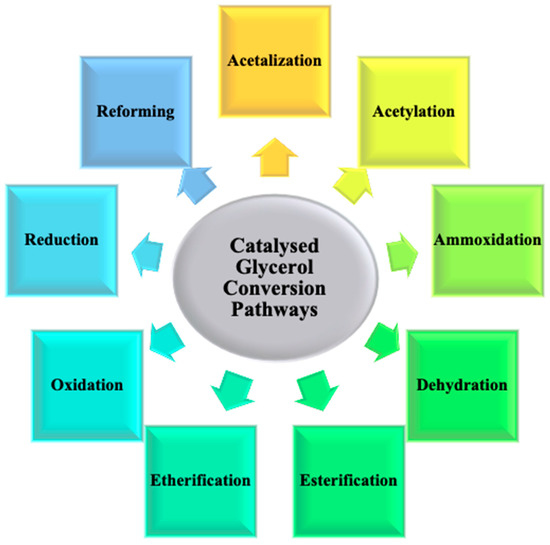
Figure 3.
Various glycerol catalytic conversion pathways [37].
During acetalization, glycerol reacts with C=O molecules to produce isomeric six-membered (1,3-dioxane) and five-membered (1,3-dioxolane) cyclic compounds. However, for the application of a six-membered acetal that has a maximum conversion of 72% and selectivity of 60%, no equivalent ratio of those products has been documented [38]. Under solvent-free conditions at 55 °C, 100% conversion and 99% yield to solketal were achieved with high catalyst loadings (10 wt%) and high heteropolyacid loadings (20 wt% of phosphotungstic acid) [39]. However, heteropolyacids usually exhibit poor thermal stability, limited regeneration ability and minimal surface area [40]. Glycerol acetylation creates acetins (mono-, di- and tri-esters of glycerol), which are extensively used as fuel additives [41]. Acetins are widely synthesized commercially by using homogeneous Bronsted acid-catalyzed method with acetic acid. However, homogeneous acid catalysts are caustic, non-reusable, difficult to separate from the reaction mixture, and water sensitive. Novel catalyst preparation approaches to incorporate a range of active sites across the matrix surface have been used to solve these difficulties [42]. Glycerol ammoxidation involves producing acrylonitrile directly using mono- and mixed-oxide catalysts. The catalysts must be chosen carefully to ensure that the ammonia does not block the acidic centers of the catalysts. A total conversion rate of 100% with a selectivity of 48% had been reported [43]. With the use of unpromoted molybdenum catalysts that were supported on gamma-alumina (10% Mo/-Al2O3), 26% nitriles were produced. The amount of weak/moderate acid sites on the support surface as well as the molybdenum content and oxidation states are significant criteria for catalyst tuning [44]. Acrolein, which is one of the most important glycerol dehydration products, is used to make a variety of compounds such as 1,3-propane diol, methionine, and pyridines. The acidity and textural qualities of the catalyst are particularly important in this reaction. The synthesis of acrolein is more favorable at medium to strong acid sites. However, stronger acid sites may also stimulate the creation of coke, which results in faster catalyst deactivation [14]. Dehydration of glycerol to value-added acrolein using zeolite catalysts was recently reported with 100% glycerol conversion and strong acrolein selectivity (88%). On the other hand, the shape of the catalysts with lengthy channels showed slow internal diffusion, resulting in more polymerization side reactions and coke generation [45]. Glycerol esterification is traditionally carried out with homogeneous Bronsted acid catalysts, which are highly corrosive and have several technical and environmental problems. As an alternative, heterogeneous catalysts demonstrate good activity in the esterification reaction. However, their costs, complicated synthesis and functionalization procedures, pore size limitation and reutilization remain unresolved challenges for industrial applications [46]. Amberlyst-35 catalyst was used in the procedure, which resulted in 65% selectivity and nearly 100% glycerol conversion [47]. Catalytic glycerol etherification for profitable polyglycerol (particularly di- and triglycerol) synthesis is one of the promising waste glycerol utilization technologies [7]. Short and long-chain polyglycerols are produced by etherification of glycerol using magnesium-aluminum layered double hydroxides (LDHs), which is more effective in the presence of heterogeneous catalysts (Mg:Al molar ratio of 1:1) with a selectivity of more than 99% towards short-chain polyglycerols and 52.1% glycerol conversion [13]. The most researched metallic catalysts such as palladium (Pd), platinum (Pt) and aurum (Au) are used to oxidize glycerol in order to create glyceraldehyde, dihydroxyacetone and glyceric acid. During the oxidation of glycerol, platinum-based catalysts were deactivated due to oxygen poisoning. Consequently, many methods were proposed to reduce the deactivation of the platinum catalyst. The use of a Pt–Au catalyst could prevent deactivation but also reduces the selectivity toward glyceric acid by 3%, especially at long reaction periods (t = 3 h). However, the catalyst still achieved high glycerol conversion at 97% [48]. Platinum-based electro-catalysts possess good chemical stability and high catalytic activity, but they are rare in nature, expensive and can cause CO poisoning. The creation of strong adsorption intermediates on the surface of electro-catalysts indicates a decrease in their activity throughout the oxidation reaction [16]. Hydrogenolysis is a type of reduction reaction that involves the breakdown of chemical bonds in an organic substrate and the simultaneous addition of hydrogen to the resultant molecular fragments to produce mainly 1,2-propanediol (1,2-PD) and ethylene glycol. Alumina-supported copper catalysts achieved 100% conversion with 96.9% selectivity for 1,2-PD and 1.4% selectivity for ethylene glycol. On the other hand, Cu-based hydrogenolysis catalysts are unique to the conversion process of glycerol to 1,2-PD. Other types of hydrogenolysis catalysts should be developed to obtain other products [49]. This is because the three-dimensional continuous large pore structure was extremely active and selective for 1,3-propanediol (1,3-PD). It enables the entry of the reactant and the exit of the product, tungsten-doped siliceous mesocellular foams (W-MCFs) that were supported by Pt catalysts. Pt/W-1.5MCFs with a 1.5 mass ratio of 1,3,5-trimethylbenzene (TMB) recorded the best activity and 1,3-PD selectivity among the Pt/W-MCFs catalysts. With a selectivity of 65% at high glycerol conversion, the greatest 1,3-PD yield of 63% was achieved [50]. Hydrogen was produced from glycerol reformation using a two-stage fixed bed device. The first fixed bed employed a calcined dolomite catalyst, whereas the second fixed bed used a nickel-based catalyst to produce hydrogen from glycerol steam reforming. The results showed that both the hydrogen yield and carbon conversion increased when the temperature was increased. As the temperature approached 800 °C, the rates of hydrogen output and carbon conversion were reduced. The hydrogen output was as high as 84.3% under ideal reaction conditions, while the carbon conversion was recorded up to 88.23% [51]. Among the various pathways available to utilize glycerol, the etherification of glycerol to polyglycerols is gaining importance due to the possibility of controlling their hydrophilic-lipophilic balance. Even though various reactions using allylic ethers, glycidol or epichlorohydrin can be used to produce polyglycerols, etherification of glycerol is a more environmentally friendly method [52]. Table 1 gives a summary of the catalyzed glycerol conversion processes, highlighting the benefits and drawbacks of each procedure.

Table 1.
Advantages and disadvantages of catalyzed glycerol conversion process.
3. Glycerol Etherification Experimental Setup
A solvent-based glycerol etherification reaction was carried out in a stainless-steel autoclave reactor with a Teflon inner layer at temperatures ranging from 80 °C to 160 °C. On a high throughput batch reactor system that was made up of ten independent stainless-steel autoclave reactors with mechanical stirring, the autoclaves were maintained in an oil bath and were vigorously swirled by a magnetic stirrer [11]. The reaction mixture was heated to 70 °C in 0.5 h, whereas each reaction typically lasted for 7 h at the reaction conditions [12]. A stainless-steel jacketed batch reactor was subjected to a stirring frequency of 1200 min−1 in order to limit the influence of external mass transfer phenomena [55,56]. Fixed bed flow reactor was also used for this reaction in a temperature range of 70 °C to 110 °C [57] with various pressure conditions such as vacuum pressure with continuous removal of water which was formed during the reaction [58], autogenous pressure of 0.5 MPa [15] up to 1.5 MPa [16,59] as well as specified pressure in the range of 2.5 bar at room temperature and upon heating to 80 °C [60] for 40 min which increased the pressure from 12 bar [61] to 20 bar [62]. The effect of various solvents (e.g., tert-butyl alcohol, isobutene, benzyl alcohol, ethanol and isoamylene) on glycerol molar ratio from 1 [58] to 20 [63] had been studied, while the reaction temperature ranged from 60 °C to 200 °C, depending on the solvent used in etherification. The glycerol etherification was conducted over different catalysts with the concentration that varied from 1.5 wt% [64] to 33.3 wt% [65] for a reaction time of 0.25 h [66] up to 72 h [62]. The solvent-free glycerol etherification was carried out at atmospheric pressure in a three-necked round bottom flask [23,24,25,26,27,28] or microwave reactor [67,68,69,70,71,72]. The etherification reaction was conducted at a temperature ranging from 200 °C [73] up to 280 °C [74,75] in the span of 3 h [67] up to 24 h [76,77,78,79] under a continuous nitrogen gas flow to prevent the oxidation of glycerol. Water, which was the by-product of solvent-free glycerol etherification, was removed from the reaction vessel using the Dean–Stark distillation apparatus [23,24,25,26,27,28]. The reaction was catalyzed over different catalysts with concentrations ranging from 0.5 wt% to 5 wt% under continuous stirring [80].
4. Reaction Mechanisms
The study of the fundamental reaction mechanism is vital for a variety of reasons, including improving chemical reactions and exploring alternate reaction paths. In the case of glycerol etherification, an in-depth look at the reaction mechanism reveals the various types of reaction mechanisms available for converting glycerol into short-chain polyglycerols, thus allowing the selection of reaction conditions that favor one path over another and predicting the outcome of relatively unknown reaction pathways. Figure 4 depicts numerous forms of glycerol etherification reaction mechanisms. They can be divided into three types, namely alcohol solvents, olefin solvents and solvent-free methods. Table 2 highlights the benefits and drawbacks of each type of solvent and solvent-free approach.

Figure 4.
Types of reaction mechanisms for glycerol etherification.

Table 2.
Advantages and disadvantages of solvent and solvent free approach.
4.1. Glycerol Etherification with Alcohol Solvent
4.1.1. Tert-Butyl Alcohol (TBA)
Tert-butylation of glycerol is the process of etherifying glycerol via tert-butyl alcohol (TBA). The glycerol ether bond is formed between one carbon atom in glycerol and one tert-butyl group that is contributed by TBA during the etherification reaction. This etherification produces three general ethers, which are mono tert-butyl glycerol ether (MTBG), di tert-butyl glycerol ether (DTBG) and tri tert-butyl glycerol ether (TTBG). 1-tert-butoxypropane-2,3-diol and 2-tert-butoxypropane-1,3-diol are the structures of MTBG, while 1,2-di-tert-butoxypropan-3-ol and 1,3-di-tert-butoxypropan-2-ol are the structures of DTBG. 1,2,3-tri-tertbutoxypropane is the sole TTBG product formed. The reaction mechanism of glycerol etherification with TBA is shown in Figure 5 [41]. Besides that, the dehydration of TBA to isobutene (IB) is an independent side reaction that not only results in the undesired consumption of glycerol but also produces 3 wt% to 6 wt% of IB in the product mixture, depending on reaction conditions [56,66,81,82,83,84,85,86,87,88,89,90,91]. The production of isobutene was aided by the concentration of H3O+ ions in the reaction pathway. These ions were formed because of the hydrolysis of Sn2+ cations through water that were produced during the dehydration of alcohol [113,114]. Moreover, the formation of IB will trigger another side reaction, which is the dimerization of isobutene, leading to the formation of di-isobutene (DIB) [56,81,82,84,89]. Several researchers did not observe the formation of DIB in the glycerol etherification process when amorphous organosilica-aluminum phosphates were being utilized [86]. These two observed side reactions were facilitated by the high reaction temperature of 105 °C for MP-SO3H-8 catalyst with glycerol (Gly):tert-butyl alcohol (TBA) with a mole ratio of 1:4 [83] and 120 °C for C(10)AlPO(1.5)-250 catalysts under conventional heating with Gly:TBA that had a mole ratio of 1:4 [89], high acidity of catalyst (1.2 mmol SO3H/g) for C(10)AlPO(1.5)-250 catalysts [89] as well as high catalysts loading of above 2.5 (w/v)% TPA/H-β. Instead of glycerol etherification, high catalyst loading can catalyze TBA oligomerization to DIB [82]. Both the conversion and combined yield of di- and tri-ethers decreased beyond a molar ratio of 1:5 for Gly:TBA. Excess TBA concentration promotes the oligomerization process to generate DIB, which reduces the conversion and yield [82]. Glycerol etherification is not only affected by the number of Bronsted acid sites but also by shape selectivity mechanism of the product. In a study on zeolite catalysts with different Si/Al molar ratios and shapes, BEA catalysts with aggregated crystals demonstrated 61% glycerol conversion, 74% selectivity towards MTBG and 26% selectivity towards h-GTBE. The wide pores in the zeolites contributed to the synthesis of di-substituted ethers at a substantially lower glycerol conversion [115]. Additionally, the catalytic capability of acidic HCLIN catalyst as a sustainable green resource in etherifying glycerol was assessed. The activated HCLIN300 catalyst exhibited the highest activity (300 °C of temperature with a duration of 1 min). Tert-butanol was used to convert glycerol to mono and di-ether at a rate of 78% over the course of 4 h. Mono- and di-ethers had recorded 25% and 75% selectivity, respectively [116]. The etherification of glycerol with tert-butyl alcohol in the presence of acidic catalysts produces ethers (monoethers, diethers and triethers). The inclusion of solvents that specifically solubilize the desired products in addition to tert-butyl alcohol can change the thermodynamic equilibrium, which in turn limits the reaction. The addition of dibutyl ether causes the chemical equilibrium to change, thus boosting diether production. A stoichiometric ratio of glycerol:tert-butyl alcohol (G:TB = 1:3) and a 1:2 molar ratio of dibutyl ether:tert-butyl alcohol were determined to be the best operating conditions for maximizing glycerol conversion and selectivity towards diethers [117]. Amberlyst-35 produced the highest glycerol conversion of 87.8% [3] at 60 °C and 9 h of reaction time [5]. Stearic hindrance could lead to the formation of terminal mono-ether (1-tert-butoxypropane-2,3-diol) and di-ether (1,3-di-tert-butoxypropan-2-ol), resulting in only two products that were obtained from the etherification reaction [20]. Therefore, these unwanted side reactions will compete with the main glycerol etherification and reduce the yield of the desired products from glycerol etherification. The process by which glycerol tert-butyl ethers adsorb on acidic sites is shown in Figure 6. The proton from acid sites initiated a nucleophilic attack on the hydroxyl of tert-butyl alcohol, followed by the formation of a carbocation intermediate together with the removal of a water molecule. The carbocation intermediate could react with either the primary or secondary hydroxyl group of the glycerol molecule to form 1-tert-butoxypropane-2,3-diol or 2-tert-butoxypropane-1,3-diol, respectively. The formed diethers (DTBG) followed a similar mechanism to form triethers (TTBG) [118]. Ultimately, a variety of reaction circumstances could result in the formation of the by-product, IB which could then further react to produce DIB, thus lowering the desired yield of MTBG, DTBG and TTBG. According to the techno-economic feasibility of industrial production of biofuels via glycerol etherification reaction with TBA, the investment and operating costs for the entire process could be higher due to energy issues that were associated with the formation of water as the by-product [23].
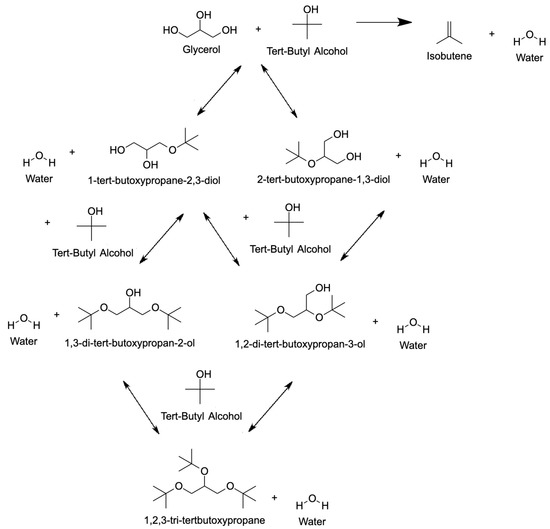
Figure 5.
Glycerol etherification process with tert-butyl alcohol [91].
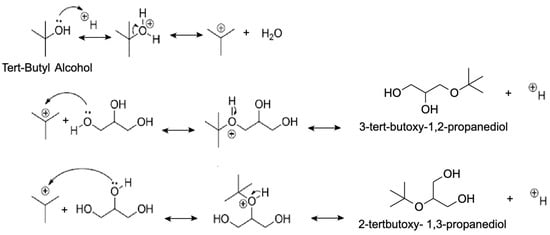
Figure 6.
Suggested process in developing 3-tert-butoxy-1,2-propanediol and 2-tertbutoxy-1,3-propanediol through absorbing tert-butyl alcohol upon acid regions [118].
4.1.2. Ethanol
As for the glycerol etherification with ethanol, the products include two mono-ethyl glycerol ethers (MEG), two di-ethyl glycerol ethers (DEG) and a tri-ethyl glycerol ether (TEG). In general, the etherification reaction consists of an ether bond formation between one hydroxyl group of glycerol and an ethyl group from the ethanol molecule and the loss of a water molecule via a condensation reaction, which is shown in Figure 7. The formation of diethyl ether (DEE) is the major independent side reaction from ethanol self-etherification, which can be attributed to the high ethanol-to-glycerol molar ratio and high reaction temperature [92,93,94,95]. The acidity of the catalyst favors the formation of DEE, which reduces glycerol [93]. A recent study on glycerol etherification with ethanol in a fixed bed reactor catalyzed by Amberlyst 15 found that the best conditions were temperature (269 °C), 12:1 molar ratio of ethanol:glycerol, catalyst quantity (0.78 g) and pressure (2.5 MPa), which resulted in 97% glycerol conversion [119]. Two mechanisms for glycerol etherification with ethanol were proposed. In the first proposed mechanism, an oxone ion is generated via the protonation of glycerol on a Bronsted acid, which eventually reacts with the ethanol to form mono ethyl glycerol ethers as shown in Figure 8A. The other proposed mechanism indicates that the formation of glycerol ethyl ethers can proceed via an SN2 mechanism which involves the glycerol molecule that initiates a nucleophilic attack on the protonated ethanol with the loss of a water molecule as depicted in Figure 8B. Figure 8C shows the formation of diethyl ether, which also follows the SN2 mechanism as the protonated ethanol molecule acts as an electrophile while another ethanol molecule acts as a nucleophile [118].
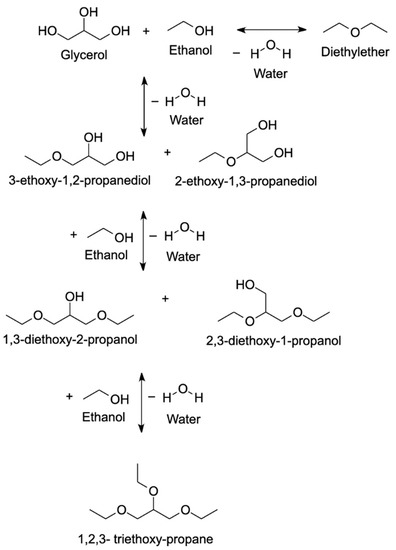
Figure 7.
Reaction mechanism of glycerol etherification with ethanol [93].
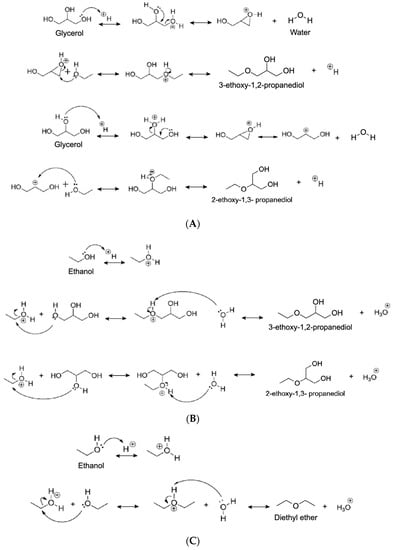
Figure 8.
(A) Proposed mechanism in developing 3-ethoxy-1,2-propanediol and 2-ethoxy-1,3- propanediol via the protonation of glycerol [118]; (B) Proposed mechanism for the protonation of ethanol as the mechanism in developing 3-ethoxy-1,2-propanediol and 2-ethoxy-1,3-propanediol [118]; (C) Proposed mechanism for the formation of diethyl ether [118].
4.1.3. n-Butanol
When glycerol is etherified with n-butanol, it produces glycerol ether products that are bonded with the substituted butyl groups, which include two mono-butyl glycerol ethers (MBGE), two di-butyl glycerol ethers (DGBE) and a tri-butyl glyceryl ether (TBGE): 1-((1,3-dibutoxypropan-2yl)oxy)butane, which is shown in Figure 9. In Figure 10, dehydration of butanol to butane, isomerization of butane to isobutene (IB), dimerization of butanol to butyl ethers and oxidation of butanol to butyraldehyde are several potential side reactions of n-butanol. It has been observed that butanol has an independent side reaction in the etherification of glycerol with n-butanol over various acidic metal catalysts, resulting in the synthesis of dibutyl ether (DBE). The monophasic reaction medium accounts for the high solubility of glycerol in alcohol. However, no glycerol conversion was detected under these conditions because a temperature of 70 °C was insufficient to promote the activation of the linear alcohol [117]. The product selectivity to glycerol ethers can only be better controlled by operating at moderate conditions, even though a reaction temperature as high as 200 °C was found to be favorable in terms of glycerol conversion in order to attain up to 90% conversion. At higher temperatures, the contribution of side dehydration and self-etherification of both n-butanol and glycerol may become competitive [96]. Under the temperature of 150 °C, the production to butyl glyceryl monoether and conversion of n-butanol were recorded for 45% and 91% correspondingly, while the minimal catalyst loading of 3 mol% H+ reduced the production to DBE by-product to 6% [97]. The reactivity of glycerol and n-butanol within an autoclave under the temperature of 140 °C along with a dry Amberlyst-36 catalyst resulted in a 98% conversion of glycerol with an 88% product selectivity. In the presence of glycerol, the denser the structure of the sulfonated cation exchange resins, the lower the selectivity of the by-product DBE [98].
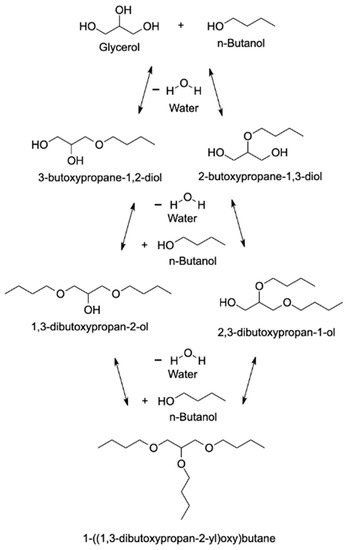
Figure 9.
Reaction mechanism of glycerol etherification with n-butanol [120].
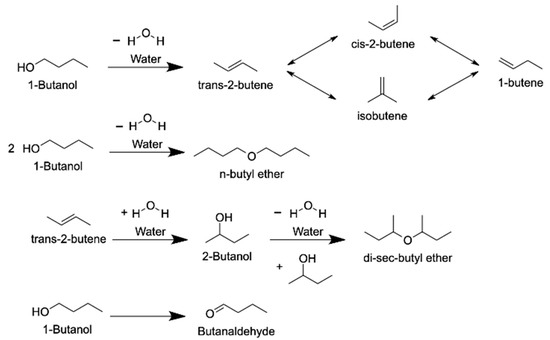
Figure 10.
Potential side reactions of butanol as reactant [120].
4.1.4. Benzyl Alcohol
The prominent products obtained from the etherification of glycerol (Gly) with benzyl alcohol (BA) include two mono-benzyl glycerol ether isomers (ME), two di-benzyl glycerol ether isomers (DE) and tri-benzyl glycerol ether (TE) as illustrated in Figure 11. Each reaction is reversible and controlled by the equilibrium concentration of the intermediates formed. The formation of dibenzyl ether (BE) from the dimerization of benzyl alcohol will reduce the yield of the desired product as it competes with benzyl alcohol when utilizing benzyl alcohol in the glycerol etherification reaction [99]. The H+ ions are available for the protonation of BA, thus resulting in the loss of a water molecule and becoming a primary carbocation. It is then attacked by either a glycerol molecule or another BA, leading to the formation of BE. The retention of the water molecules could also lower the yield of dibenzyl glycerol ethers and tri-benzyl glycerol ethers as it shifts the equilibrium towards the reactants [19]. In addition to the BE, other undesired by-products such as toluene, benzaldehyde and stilbene have been detected but in very low concentrations as shown in Figure 11 and Figure 12 [99]. The benzylation of glycerol was described as an SN2 reaction with the generation of benzyl cations on catalyst surfaces as shown in Figure 13. There are three competing reactions involved, including the reaction of benzyl cation in situ production with glycerol to generate mono-benzyl glycerol ether, the reaction of mono-benzyl glycerol ether with another benzyl cation to form di-benzyl glycerol ether, and the formation of dibenzyl ether via the process of self-etherifying benzyl alcohol [100]. Benzyl alcohol was etherified using zirconia-based heterogeneous acid catalysts, which were then modified with sulfuric acid that led to the formation of mono- and dibenzyl glycerol ethers. The conversion of benzyl alcohol rose between 120 °C and 140 °C, with the maximum BA conversion being achieved via the use of 2S/ZrO2 catalyst. The benzyl ether selectivity decreased as the Gly:BA initial mass ratio was increased. On the contrary, BE selectivity increased as the temperature was raised [121]. The Cs–SO3H catalysts provided 97% conversion and 79% selectivity towards mono benzyl glycerol ethers under reaction conditions of 3:1 Gly:BA alcohol molar ratio, 10% catalyst weight, 393 K, and 360 min of reaction time. The highest selectivity for the by-product BE was obtained using Cs–SO3H catalyst at the reaction temperature of 393 K and a molar ratio of 1:1. The presence of a significant amount of BE could be explained by the fact that the water formed in the reaction medium was not being eliminated [122].
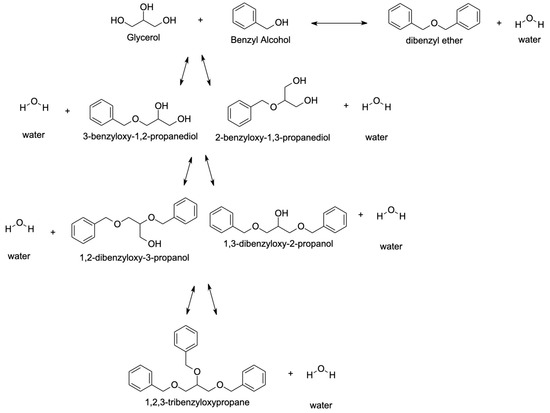
Figure 11.
Reaction mechanism of glycerol etherification with benzyl alcohol [99].

Figure 12.
Undesired side reaction using benzyl alcohol as reactant [99].
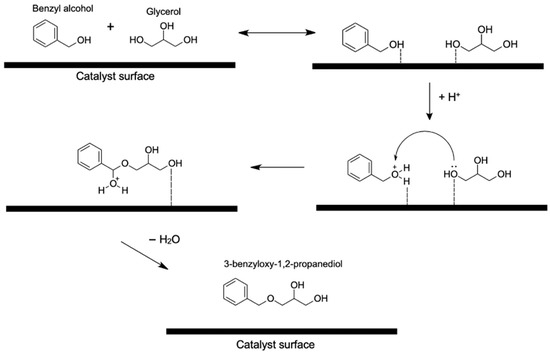
Figure 13.
Benzylation of glycerol implying SN2 mechanism [100].
4.2. Glycerol Etherification with Olefin Solvent
4.2.1. Isobutene
The reaction products of isobutene (IB) with glycerol (Gly) include two mono-ethers, two di-ethers and a tri-ether as shown in Figure 14A [103]. As an independent side reaction, the formation of the undesirable (E)-2,5-dimethylhex-3-ene from the dimerization of isobutene has been reported in many literature studies [56,101,102,103,104,105,106,107,108,109]. The dimerization reaction is thought to be irreversible, and the related products must be removed from the mixture since they tend to develop deposits in diesel engines [23]. The high acidity of the catalyst such as Amberlyst-15 (A-15) catalyst with a high acidity value of 4.5 (meqH+g−1cat) was ascribed to a large amount of DIB being produced (10.2%). Strong acid ion exchange resin enhances isobutene oligomerization as a side reaction and produces a considerable amount of DIB, which impairs glycerol etherification conversion and selectivity. Furthermore, the hydrophobic or hydrophilic characteristics of the surface catalyst could affect IB surface retention, which could influence the oligomerization reaction. For example, the presence of divinylbenzene matrix in A-15 catalysts may favor IB adsorption, thus encouraging DIB production [56]. Only 0.2 wt% of DIB was formed in carbon spheres that were prepared by hydrothermal treatment and immersed in concentrated HNO3 at room temperature, followed by an incipient wetness procedure using an alcoholic solution that contained 5% fluorinated ionomer that had an acidity value of 1.90 (meqH+g−1cat). A-15 catalysts with an acidity of 4.5 (meqH+g−1cat) which were used at a reaction condition of 4:1 molar ratio of IB: Gly under the temperature of 70 °C for 6 h with 7.5 wt% of catalysts resulted in the formation of 8.0 wt% DIB [101]. The production of DIB rose from 0.1 wt% to 0.5 wt% as the amount of catalyst rose from 1 wt% to 7 wt% when utilizing a sulfonated graphene catalyst (SG) that was produced by grafting with sulfonic acid. This demonstrated that high catalyst loading favors DIB production [104]. More di-isobutene is formed at high temperatures because the rate of isobutene dimerization is temperature-sensitive. Furthermore, at a 3:1 molar ratio of IB/G mole under the temperature of 80 °C, the selectivity of isobutene to produce glycerol ethers was optimal, while surpassing this stoichiometric ratio resulted in excessive DIB synthesis [109]. Insight into the relationships between catalyst structure and performance can be gained from the differences in acid strength for resin catalysts via different levels of cation exchange. It had been reported that basic ion exchange resins such as Amberlyst-15 (dry) enhanced the selectivity of the desired glycerol ethers when it was treated with an aqueous solution of sodium nitrate for 12 h at room temperature for the interchange of sodium ions, whereas isobutene dimerization was suppressed as acid strength increased. According to phase behavior analysis, the reaction mixture of glycerol and isobutene separates into two liquid phases throughout the reaction. The generated mono-ethers of glycerol thermodynamically promote the homogeneity of the two liquid phases, thus accelerating the reaction rates due to the availability of isobutene on the active sites. It is hypothesized that increasing the concentration of isobutene in the reaction phase causes all reactions to accelerate [123]. Due to the sheer invariant concentrations of reactants in the reaction phase, the initial rate of mono-ether synthesis from glycerol and isobutene was independent of the starting composition. It has been discovered that the glycerol-isobutene reaction speeds up the conversion of glycerol by boosting the solvation of isobutene in glycerol as the mono-ethers are produced and persisted in the reaction system [124]. The best heterogeneous catalytic results for glycerol etherification with isobutene using Amberlyst-39 wet catalysts were 100% glycerol conversion with 93% selectivity towards Sh-GTBE over an 8-h reaction time with reaction conditions of 60 °C, 7.5 wt% of catalyst loading and a 4-molar ratio of [125].
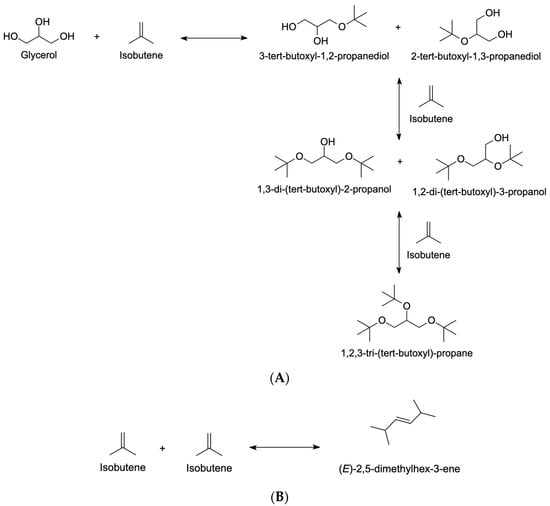
Figure 14.
(A) Reaction mechanism of glycerol etherification with isobutene [103]; (B) Reaction mechanism of dimerization of isobutene [103].
4.2.2. 1-Butene
The etherification of glycerol with 1-butene involves a set of consecutive equilibrium reactions to produce mono-ethers, di-ethers, and tri-ethers as products. These products include two mono-butyl glycerol ethers, two di-butyl glycerol ethers and a tri-butyl glycerol ether. The undesired side reaction was the formation of a dimer (di-1-butene) from the dimerization of 1-butene, whereby the solvent was consumed in a large proportion that could affect the formation of the desired ethers. The reaction mechanism for glycerol etherification with 1-Butene is shown in Figure 15A, while Figure 15B shows the reaction mechanism for dimerization of 1-butene. The acid sites of the catalyst protonate the double bond in 1-butene and convert it into a Lewis acid (electron acceptor), while the hydroxyl groups of the molecule of glycerol remain as the Lewis base (electron donor). The etherification reaction proceeds as the hydroxyl group reacts with the 2-butyl cation to form the C-O single bond and yield the mono-ether molecule. The position of the hydroxyl group in the glycerol molecule that reacts with the protonated 1-butene determines the possibility of forming two mono-ethers. The generated mono-ethers reacted with another cation intermediate to form a dative bond with an unshared pair of electrons from the oxygen atom in a secondary hydroxyl group that could be either in position 2 or position 3, resulting in the formation of 1,2-diether or 1,3-diether, respectively [62]. Furthermore, when high di-ether selectivity is required, the 1-butene conversion is highly dependent on the flow rate of glycerol. This means that even minor perturbations will cause major changes in the 1-butene recycle rate, and this phenomenon is known as the “snowball effect” [126]. For the formation of ethers from glycerol using 1-butene to be competitive, the price of the 1-butene must be decreased to half of its current price. 1-butene is a costly chemical product that raises the cost of biofuels by a factor of three when compared to biodiesel synthesis. The primary goal will be to improve the economics of the 1-butene production process [110].
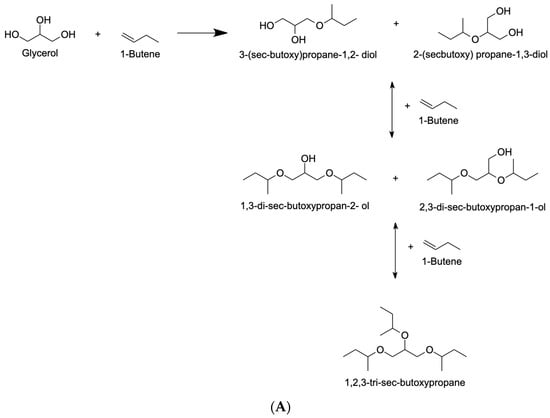
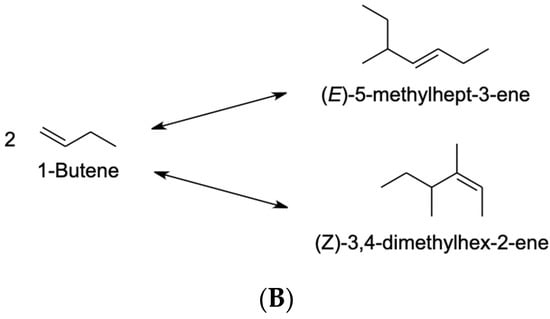
Figure 15.
(A) Reaction mechanism of glycerol etherification with 1-butene [62]; (B) Reaction mechanism of dimerization of 1-butene [62].
4.2.3. Isoamylene
Five ether products are obtained from the glycerol etherification with isoamylene, which consists of two mono-ethers, two di-ethers and a tri-ether. Figure 16 shows the tri-ether obtained from the reaction: 2-((1,3-bis(tert-pentyloxy)propane-2-yl)oxy)-2-methylbutane. A stable tertiary carbocation is formed due to the protonation of the double bond in the isoamylene molecules, which is followed by nucleophilic addition of the hydroxyl group to the glycerol in order to produce glycerol ethers. As reported in the studies using other solvents, an undesired side reaction takes place when isoamylene is reacted with glycerol in the etherification process. The undesired isomerization of isoamylene takes place when the tertiary carbonation produced by a similar mechanism undergoes a nucleophilic addition with the double bond of another unprotonated isoamylene molecule, resulting in the formation of undesired isoamylene oligomers [111]. This may be related to the thermal stabilities of both isoamylenes, whereby the relative stability is determined by the number of alkyl groups bonded to carbon atoms with double bonds. Hence, the olefins are more stable as the number increases [127]. Regardless of temperature, etherification reactions of glycerol with isoamylenes produce fewer mono-ethers but higher selectivity for di-ethers and tri-ethers. It is justified by the exceptional insolubility of glycerol in the non-polar phase, which is entirely made up of isoamylenes. The synthesis of mono-ethers appears to be the limiting step in the reaction system. It can be suggested that the inability of isoamylenes to solvate glycerol molecules can be enhanced with the use of appropriate solvents. At high temperatures, mono-ethers can easily react with isoamylenes to create di-ethers and to a lesser extent, tri-ethers. Due to the severe steric hindrance of the interaction between di-ethers and isoamylenes, the yield of tri-ether is very low in all reactions. Glycerol conversion generally increases with temperature. This is due to the improved kinetic as well as an increase in glycerol solubility in the reaction mixture. At 313 K, it can produce 2.2% glycerol conversion and a total yield of 2.2% on mono-ethers, di-ethers, and tri-ethers at a glycerol:isoamylene molar ratio of 1:1, whereas 348 K produced 7.7% conversion and a total yield of 7.1% [128].
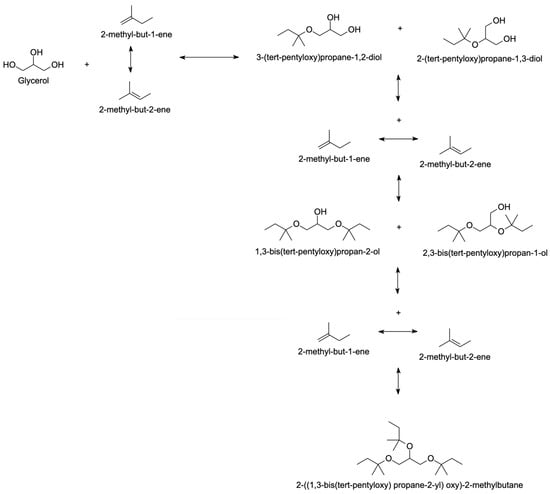
Figure 16.
Reaction mechanism of glycerol etherification with isoamylenes [111].
4.3. Solvent-Free Glycerol Etherification
Glycerol etherification that does not utilize any solvent is referred to as oligomerization of glycerol which produces short-chain oligomers of glycerol, while long-chain oligomers are referred to as polyglycerols. Through the condensation reaction, two glycerol molecules unite to produce a diglycerol molecule with the elimination of a water molecule. The formed diglycerol molecules can exist in either a linear, branching, or cyclic configuration as shown in Figure 17. 4,4′-oxybis(butane-1,2-diol) is a linear diglycerol that is generated by the removal of a water molecule when it was combined with another glycerol molecule that produces a linear triglycerol, 3,3′-[(2-Hydroxy-1,3-propanediyl)bis(oxy)]di(1,2-propanediol). Further interaction with diglycerol will result in the formation of polyglycerol. The length of polyglycerol depends on the number of glycerol or diglycerol oligomers that are joined together [72].
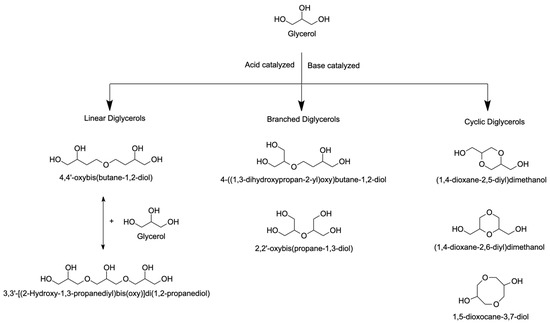
Figure 17.
Solvent-free glycerol etherification reaction forming linear-, branched- and cyclic-diglycerols [72].
The two different kinds of glycerol etherification processes are base- and acid-catalyzed reactions, which start with an acid-base contact and then progress to a catalytic reaction. The reactant serves as a base and the catalyst serves as an acid in an acid-catalyzed reaction, whereas the reactant serves as a base and the catalyst serves as an acid in a base-catalyzed reaction. The acid site of the catalyst protonates a hydroxyl group of a glycerol molecule, which is then followed by the nucleophilic attack of a hydroxyl group of another glycerol molecule. Finally, an ether is formed with the removal of a water molecule and is deprotonated to yield 4,4-oxybis(butane-1,2-diol), which is also known as diglycerol molecules. Similar reaction mechanism steps are repeated for the formation of consecutive oligomers of glycerol. Figure 18A shows two possible pathways by which this reaction can proceed: SN1 (through a carbocation) and SN2 (by a direct nucleophilic interaction). The acidic catalysts will catalyze the undesired side reaction, which is the dehydration of glycerol as shown in Figure 18B. It is then possible to extract the protonated hydroxy group as a water molecule. The hydroxy aldehyde is produced when a carbocation forms, which releases a proton. In a similar manner, the production of acrolein is caused by the double elimination of water from glycerol [112].
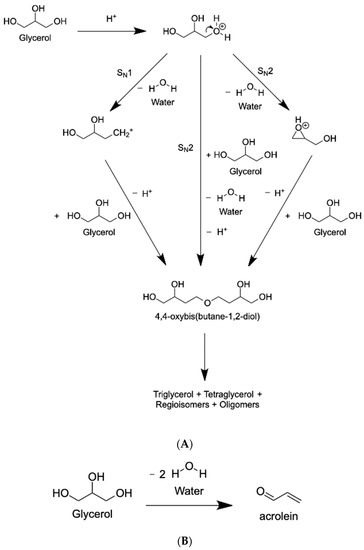
Figure 18.
(A) Reaction mechanism for solvent-free glycerol etherification with acidic catalysts [112]; (B) Undesired side reaction leading to the formation of acrolein [112].
A 100% glycerol conversion was obtained in the presence of a 3 wt% H2SO4 catalyst in 4 h on stream (TOS) at a temperature of 220 °C along with 24% and 31% di- and triglycerol selectivity, respectively [129]. Despite being more rapid, the acid-catalyzed etherification reaction is less selective because of the greater level of oligomerization that involves secondary compounds formed through dehydration and oxidation reactions. Tetra-, penta- and hexa-glycerol are likely to be produced in this reaction as dehydrated derivatives of glycerol such as alkenes, aldehydes, and ketones [7]. The production of acrolein from glycerol has been observed with an acid catalyst in the liquid phase such as sulfuric or phosphoric acid derivatives or in the gas phase with supported or non-supported tungsten and zeolite [112]. Acrolein, which is a large molecular weight molecule produced by an acid catalyst under the temperature between 250 °C and 350 °C when etherifying glycerol, could devour existing glycerol and reduce the selectivity of the desired products [130]. While homogeneous base catalysts showed higher linear glycerol selectivity, homogeneous acidic catalysts performed better at converting glycerol. The solubility and basicity of the catalysts are crucial in the reaction of glycerol etherification [7,131]. For base-catalyzed glycerol etherification, the reaction mechanism for glycerol etherification over a basic catalyst is shown in Figure 19. A hydroxyl group is deprotonated as part of the reaction. Then, the resulting alkoxy anion attacks the carbon atom of a second glycerol molecule while losing one water molecule. One of the hydroxyl groups in the glycerol molecule is protonated because the basic state offers enough hydroxyl ions to start the nucleophilic attack. The protonated molecule can then be combined with a different glycerol molecule. As a result, the protonated glycerol molecule attacks the hydroxyl group on another glycerol molecule [132,133].

Figure 19.
Reaction mechanism for solvent-free glycerol etherification with basic catalysts [132].
As a result of their significance in cosmetic, pharmaceutical, and food industries, short-chain linear polyglycerols such as di- and triglycerol have long been the subject of research. Short-chain polyglycerol synthesis using solvent-free glycerol etherification has used both homogeneous and heterogeneous catalysts. Due to their high solubility in glycerol and polymeric product, homogeneous alkaline catalysts enable rapid reactivity and avoid cyclic oligomers from being produced. However, homogeneous catalysts are not preferred because they are difficult to isolate and are not environmentally friendly [7]. Na2CO3 is frequently used for homogeneous catalysis in the process of etherifying glycerol. Prior studies suggested that it performed well due to its high alkalinity, which promoted glycerol conversion and the synthesis of short-chain polyglycerol [80,132,134]. The highest glycerol conversion obtained by a 2 wt% Na2CO3 catalyst at 260 °C in 8 h was 96% with 81% selectivity towards di-, tri- and tetraglycerols [135]. Heterogeneous catalysts have a number of advantages over homogeneous catalysts such as being easy to split up, inexpensive and renewable. According to the International Union of Pure and Applied Chemistry (IUPAC), heterogeneous base catalysts employed in solvent-free glycerol etherification can be divided into three categories: microporous (pore size: <2 nm), mesoporous (pore size: 2–50 nm), and macroporous (pore size: >50 nm) [136]. The maximum glycerol conversion of 98% was achieved using a Li/zeolite Y microporous catalyst with 21% and 32% selectivity towards di- and triglycerol, respectively, at 240 °C for 8 h with a 2 wt% catalyst loading. The catalysts had high basic strength, which was determined by Hammett Indicator analysis (9 < H < 15) [137]. X-type zeolite heterogeneous catalysts using alkali metal cations (Li+, Na+, and K+) for the direct etherification reaction of glycerol demonstrated an increase in glycerol conversion but lower diglycerol and triglycerol selectivity due to increased oligomer formation. The catalytic activity for glycerol conversion was found to be XZ-K > XZ-Li > XZ-Na, whereas the selectivity for DG and TG was found to be XZ-Li > XZ-Na > XZ-K [138]. By displaying a rise in the amount of solid basic regions as well as high total basicity and Ca dispersion, the structural firmness of intact MgAl mixed oxides is enhanced by Ca-MgAl ternary mixed oxides [139]. Ca1.6Al0.4La0.6O3 mixed metal oxide catalyst had the maximum conversion of 96% with 52% selectivity towards diglycerol for 2 wt% catalysts at 250 °C in 8 h for the mesoporous structure. In this study, triglycerol selectivity was not recorded [139]. The hydrotalcite catalyst with a Ca/Al ratio of 2:1 with a macroporous structure produced the greatest glycerol conversion of 84%, with diglycerol selectivity of 29% and triglycerol selectivity of 20%. The overall catalyst yield was 59% at 2 wt% catalyst loading and 235 °C for 24 h [71]. Mildly alkaline metal-based inorganic salts (NaHSO4 and KHSO4) act as inhibitors to increase the selectivity of the homogeneous catalytic etherification reaction for diglycerol and triglycerol synthesis while suppressing the formation of higher oligomers by limiting the activity of the catalyst. 0.37 mol% of NaHSO4 demonstrated good catalytic activity in the presence of 0.5 mol% NaOAc under a temperature of 280 °C for 2 h, with the selectivity of diglycerol and triglycerol reaching 62.6% and 28.5%, respectively, and the lowest selectivity of 9% towards other compounds [140]. Similar results were obtained from a study on the heterogeneous catalytic etherification of glycerol using the same inhibitor. The function of additive as an inhibitor reduced the conversion of glycerol, but the reaction conditions were improved by adjusting the concentrations of additives and reaction times to increase the yields of diglycerol and triglycerol. Under optimal conditions, the maximum yields of diglycerol and triglycerol were reported to be 54.1% and 21.3%, respectively, with glycerol conversion as high as 85.4% [141]. The temperature of 210 °C was the lowest temperature reported for a solvent-free glycerol etherification reaction that employed a tetra metallic hydrotalcite (MgO/NiO/ZrO2) with varying Ni loading. The catalytic data revealed a maximum glycerol conversion of 55% with full selectivity towards diglycerols after 24 h of reaction. Increased reaction temperature promotes the creation of triglycerol and tetraglycerols, resulting in uncontrolled polymerization and the production of compounds of low industrial interest [142].
5. Future Recommendations
Converting glycerol via glycerol etherification into value-added molecules has been investigated due to its broad availability, renewability, and unique properties. According to the assessment, each mechanism has its own set of processes that lead to the formation of the desired end products. Despite these drawbacks, solvent-based mechanisms have been extensively studied in the past, and their applications are suitable for a wide range of industrial applications. Solvent-free glycerol etherification has gained popularity lately, thus allowing for more novel mechanistic routes to be proposed. Water molecules are common by-products of the reaction, and water separation is a relatively straightforward process. Furthermore, the solvent-free process eliminates the need for a high-pressure apparatus, thus lowering the expense of the etherification procedure. As a result, more industrial production may use solvent-free glycerol etherification because it is more commercially viable and environmentally friendly. One of the difficulties which many researchers often encounter is the selective etherification of glycerol to produce the appropriate fraction of polyglycerols, specifically short-chained polyglycerols (di- to pentaglycerols). Future research should focus on solvent-free selective etherification of glycerol in order to create short-chained polyglycerol under less stringent circumstances such as shorter heterogeneous catalyst preparation times, reaction temperatures between 200 and 220 °C, and more effective reactor setup modifications such as a comparison study between fixed bed and fluidized bed reactor system, high-pressure vessel during catalysts synthesize, incorporating the usage of ultrasonication or microwave irradiation during the etherification. This will encourage the development of short-chained polyglycerol-based surfactants that suit the requirements of the food and cosmetics industries.
6. Conclusions
By removing the mass transfer limitation between phases, it was claimed that adding tert-butyl alcohol (TBA) might prevent the development of isobutene oligomerization and increase the selectivity toward ethers. The usage of TBA as one of the feed reactants could reduce the selectivity for ethers due to the formation of water molecules during the reaction. Other studies had documented the impact of water content on catalytic activity resulting in high operational costs associated with TBA as solvent despite it favoring a lower pressure system. Since a substantial amount of diethyl ether was generated as a by-product of the process, a large amount of ethanol was required to achieve the appropriate level of glycerol conversion. Thus, rendering ethanol economically not feasible. Using n-butanol as a solvent that is susceptible to a variety of side reactions, including oxidation, dimerization, and dehydration results in decreased glycerol conversion. The reaction of aliphatic primary alcohols with glycerol is problematic when benzyl alcohol is utilized as a solvent. The production of the carbocation is the limiting step. The polarity variation between fatty alcohols and glycerol raises questions about miscibility. Moreover, the dimerization of the solvent further decreases the yield of the desired mono-ethers. Isobutene as a solvent improves catalytic performance for glycerol etherification, but more isobutene is required for the same amount of glycerol. Since the reaction only requires medium-strength acid sites to form carbenium ions, the presence of acid catalysts affects the conversion. Higher acid concentrations may result in the production of undesirable di-isobutene, which could also be produced at higher reaction temperatures; hence, reducing glycerol etherification conversion and selectivity. A major disadvantage of this solvent is the huge amount of 1-butene consumed during the side reaction. As a result, the hydroxyl group that is accessible for the glycerol etherification step is limited. The undesirable isoamylene oligomerization that results from a nucleophilic addition of tertiary carbocation reduces the intended conversion ratio of glycerol ether, placing the solvent out of favor for further optimization. Solvent-free glycerol etherification research is gaining attraction since the by-product created is primarily water, which can be eliminated from the reaction. In this regard, the solvent-free etherification process may offer various benefits. Using an acid catalyst in a solvent-free glycerol etherification process could result in an unwanted side reaction that involved glycerol dehydration, whereby the twofold elimination of water from glycerol leads to the formation of acrolein. The catalytic results of base-catalyzed solvent-free glycerol etherification was promising with no significant acrolein production. Homogeneous alkaline catalysts offer quick reactivity while preventing the development of cyclic oligomers. Homogeneous catalysts, on the other hand, are not chosen since they are difficult to isolate and are not ecologically benign. In comparison to homogeneous catalysts, heterogeneous catalysts have a number of benefits, including being cheap, renewable, and simple to separate. Nevertheless, the reaction is unstable towards ambient water and carbon dioxide. For both academic research and industrial applications, glycerol transformation is a continuous process. Researchers can apply relevant fundamental knowledge of the reaction process to tweak existing methods or propose new ones to improve the selectivity and conversion of glycerol with minimal unwanted side products and environmental problems.
Author Contributions
Conceptualization, P.P. and S.L.; validation, P.P., S.L., Y.H.Y. and L.K.L.; formal analysis, P.P.; investigation, P.P.; resources, P.P.; data curation, P.P. and S.L.; writing—original draft preparation, P.P.; writing—review and editing, P.P., S.L., Y.H.Y. and L.K.L.; visualization, P.P. and S.L.; supervision, S.L., Y.H.Y. and L.K.L.; project administration, S.L., Y.H.Y. and L.K.L.; funding acquisition, P.P., S.L. and Y.H.Y. All authors have read and agreed to the published version of the manuscript.
Funding
This research was funded by Universiti Tunku Abdul Rahman (UTAR), grant number UTARRF/2021-C1/P01.
Acknowledgments
We extend our gratitude to acknowledge the financial support from Universiti Tunku Abdul Rahman (UTAR), grant number UTARRF/2021-C1/P01.
Conflicts of Interest
The authors declare no conflict of interest. The funders had no role in the design of the study; in the collection, analyses, or interpretation of data; in the writing of the manuscript; or in the decision to publish the results.
References
- Villa, A.; Dimitratos, N.; Chan-Thaw, C.E.; Hammond, C.; Prati, L.; Hutchings, G.J. Glycerol Oxidation Using Gold-Containing Catalysts. Acc. Chem. Res. 2015, 48, 1403–1412. [Google Scholar] [CrossRef] [PubMed]
- Li, Y.; Zhang, S.; Li, Z.; Zhang, H.; Li, H.; Yang, S. Green Synthesis of Heterogeneous Polymeric Bio-Based Acid Decorated with Hydrophobic Regulator for Efficient Catalytic Production of Biodiesel at Low Temperatures. Fuel 2022, 329, 125467. [Google Scholar] [CrossRef]
- Saikia, K.; Saikia, K.; Rajkumari, K.; Moyon, N.S.; Basumatary, S.; Halder, G.; Rashid, U.; Rokhum, S.L. Sulphonated Biomass-Based Catalyst for Solketal Synthesis by Acetalization of Glycerol—A Byproduct of Biodiesel Production. Fuel Process. Technol. 2022, 238, 107482. [Google Scholar] [CrossRef]
- Foo, G.S.; Wei, D.; Sholl, D.S.; Sievers, C. Role of Lewis and Brønsted Acid Sites in the Dehydration of Glycerol over Niobia. ACS Catal. 2014, 4, 3180–3192. [Google Scholar] [CrossRef]
- Alashek, F.; Keshe, M.; Alhassan, G. Preparation of Glycerol Derivatives by Entered of Glycerol in Different Chemical Organic Reactions: A Review. Results Chem. 2022, 4, 100359. [Google Scholar] [CrossRef]
- Roy, D.; Subramaniam, B.; Chaudhari, R.v. Cu-Based Catalysts Show Low Temperature Activity for Glycerol Conversion to Lactic Acid. ACS Catal. 2011, 1, 548–551. [Google Scholar] [CrossRef]
- Chong, C.C.; Aqsha, A.; Ayoub, M.; Sajid, M.; Abdullah, A.Z.; Yusup, S.; Abdullah, B. A Review over the Role of Catalysts for Selective Short-Chain Polyglycerol Production from Biodiesel Derived Waste Glycerol. Environ. Technol. Innov. 2020, 19, 100859. [Google Scholar] [CrossRef]
- Fortune Business Insights Sample_Global Glycerine Market Analysis Insights and Forecast, 2021–2028. 2021. Available online: https://www.fortunebusinessinsights.com/glycerine-market-102168 (accessed on 5 October 2022).
- Yamamoto, K.; Kiyan, A.M.; Bagio, J.C.; Rossi, K.A.B.; Delabio Berezuk, F.; Berezuk, M.E. Green Cyclic Acetals Production by Glycerol Etherification Reaction with Benzaldehyde Using Cationic Acidic Resin. Green Process. Synth. 2019, 8, 183–190. [Google Scholar] [CrossRef]
- Wang, Z.; Wang, L.; Jiang, Y.; Hunger, M.; Huang, J. Cooperativity of Brønsted and Lewis Acid Sites on Zeolite for Glycerol Dehydration. ACS Catal. 2014, 4, 1144–1147. [Google Scholar] [CrossRef]
- Nomanbhay, S.; Hussein, R.; Ong, M.Y. Sustainability of Biodiesel Production in Malaysia by Production of Bio-Oil from Crude Glycerol Using Microwave Pyrolysis: A Review. Green Chem. Lett. Rev. 2018, 11, 135–157. [Google Scholar] [CrossRef]
- Davies, T.E.; Kondrat, S.A.; Nowicka, E.; Graham, J.J.; Apperley, D.C.; Taylor, S.H.; Graham, A.E. Dehydrative Etherification Reactions of Glycerol with Alcohols Catalyzed by Recyclable Nanoporous Aluminosilicates: Telescoped Routes to Glyceryl Ethers. ACS Sustain. Chem. Eng. 2016, 4, 835–843. [Google Scholar] [CrossRef]
- Khumho, R.; Tocuweang, K.; Sangkhum, P.; Kuchonthara, P.; Ashokkumar, V.; Ngamcharussrivichai, C. Etherification of Glycerol into Short-Chain Polyglycerols over MgAl LDH/CaCO3 Nanocomposites as Heterogeneous Catalysts to Promote Circular Bioeconomy. Chemosphere 2022, 291, 133091. [Google Scholar] [CrossRef] [PubMed]
- Bhaduri, K.; Ghosh, A.; Auroux, A.; Chatterjee, S.; Bhaumik, A.; Chowdhury, B. Soft-Templating Routes for the Synthesis of Mesoporous Tantalum Phosphates and Their Catalytic Activity in Glycerol Dehydration and Carbonylation Reactions. Mol. Catal. 2022, 518, 112074. [Google Scholar] [CrossRef]
- Qureshi, F.; Yusuf, M.; Pasha, A.A.; Khan, H.W.; Imteyaz, B.; Irshad, K. Sustainable and Energy Efficient Hydrogen Production via Glycerol Reforming Techniques: A Review. Int. J. Hydrogen Energy, 2022; in press. [Google Scholar] [CrossRef]
- Pereira, V.S.; Nandenha, J.; Ramos, A.; Neto, A.O. Effects of TiO2 in Pd-TiO2/C for Glycerol Oxidation in a Direct Alkaline Fuel Cell. J. Fuel Chem. Technol. 2022, 50, 474–482. [Google Scholar] [CrossRef]
- Maquirriain, M.A.; Querini, C.A.; Pisarello, M.L. Glycerine Esterification with Free Fatty Acids: Homogeneous Catalysis. Chem. Eng. Res. Des. 2021, 171, 86–99. [Google Scholar] [CrossRef]
- Bagnato, G.; Iulianelli, A.; Sanna, A.; Basile, A. Glycerol Production and Transformation: A Critical Review with Particular Emphasis on Glycerol Reforming Reaction for Producing Hydrogen in Conventional and Membrane Reactors. Membranes 2017, 7, 17. [Google Scholar] [CrossRef]
- Chiosso, M.E.; Casella, M.L.; Merlo, A.B. Synthesis and Catalytic Evaluation of Acidic Carbons in the Etherification of Glycerol Obtained from Biodiesel Production. Catal. Today 2021, 372, 107–114. [Google Scholar] [CrossRef]
- da Silva, M.J.; Chaves, D.M.; Ferreira, S.O.; da Silva, R.C.; Gabriel Filho, J.B.; Bruziquesi, C.G.O.; Al-Rabiah, A.A. Impacts of Sn(II) Doping on the Keggin Heteropolyacid-Catalyzed Etherification of Glycerol with Tert-Butyl Alcohol. Chem. Eng. Sci. 2022, 247, 116913. [Google Scholar] [CrossRef]
- Liu, J.; Jiang, Y.; Zhang, P.; Yang, B. Enhance Glycerol Conversion through Co-Etherification with Isobutene and Tert-Butanol. Fuel Process. Technol. 2021, 218, 106838. [Google Scholar] [CrossRef]
- Sakdasri, W.; Ngamprasertsith, S.; Saengsuk, P.; Sawangkeaw, R. Supercritical Reaction between Methanol and Glycerol: The Effects of Reaction Products on Biodiesel Properties. Energy Convers. Manag. X 2021, 12, 100145. [Google Scholar] [CrossRef]
- Cannilla, C.; Giacoppo, G.; Frusteri, L.; Todaro, S.; Bonura, G.; Frusteri, F. Techno-Economic Feasibility of Industrial Production of Biofuels by Glycerol Etherification Reaction with Isobutene or Tert-Butyl Alcohol Assisted by Vapor-Permeation Membrane. J. Ind. Eng. Chem. 2021, 98, 413–424. [Google Scholar] [CrossRef]
- Lopez-Suarez, F.E.; Riveros-Riveros, D.M.; Cesteros, Y.; Salagre, P. Raw Glycerol Re-Valuing through Etherification with Isobutylene: Process Design and Techno-Economical Assessment. J. Ind. Eng. Chem. 2021, 94, 159–165. [Google Scholar] [CrossRef]
- Andreeva, I.V.; Zaitsau, D.H.; Qian, S.; Turovtzev, V.V.; Pimerzin, A.A.; Bara, J.E.; Verevkin, S.P. Glycerol Valorisation towards Biofuel Additivities: Thermodynamic Studies of Glycerol Ethers. Chem. Eng. Sci. 2022, 247, 117032. [Google Scholar] [CrossRef]
- Wang, Z.-X.; Zhuge, J.; Fang, H.; Prior, B.A. Glycerol Production by Microbial Fermentation: A Review. Biotechnol. Adv. 2001, 19, 201–223. [Google Scholar] [CrossRef]
- Gupta, M.; Kumar, N. Scope and Opportunities of Using Glycerol as an Energy Source. Renew. Sustain. Energy Rev. 2012, 16, 4551–4556. [Google Scholar] [CrossRef]
- Ayoub, M.; Abdullah, A.Z. Critical Review on the Current Scenario and Significance of Crude Glycerol Resulting from Biodiesel Industry towards More Sustainable Renewable Energy Industry. Renew. Sustain. Energy Rev. 2012, 16, 2671–2686. [Google Scholar] [CrossRef]
- Yang, F.; Hanna, M.A.; Sun, R. Value-Added Uses for Crude Glycerol--a Byproduct of Biodiesel Production. Biotechnol. Biofuels 2012, 5, 13. [Google Scholar] [CrossRef]
- Tan, H.W.; Abdul Aziz, A.R.; Aroua, M.K. Glycerol Production and Its Applications as a Raw Material: A Review. Renew. Sustain. Energy Rev. 2013, 27, 118–127. [Google Scholar] [CrossRef]
- Veluturla, S.; Archna, N.; Subba Rao, D.; Hezil, N.; Indraja, I.S.; Spoorthi, S. Catalytic Valorization of Raw Glycerol Derived from Biodiesel: A Review. Biofuels 2018, 9, 305–314. [Google Scholar] [CrossRef]
- Cornejo, A.; Barrio, I.; Campoy, M.; Lázaro, J.; Navarrete, B. Oxygenated Fuel Additives from Glycerol Valorization. Main Production Pathways and Effects on Fuel Properties and Engine Performance: A Critical Review. Renew. Sustain. Energy Rev. 2017, 79, 1400–1413. [Google Scholar] [CrossRef]
- Dodekatos, G.; Schünemann, S.; Tüysüz, H. Recent Advances in Thermo-, Photo-, and Electrocatalytic Glycerol Oxidation. ACS Catal. 2018, 8, 6301–6333. [Google Scholar] [CrossRef]
- Adeniyi, A.G.; Ighalo, J.O. A Review of Steam Reforming of Glycerol. Chem. Pap. 2019, 73, 2619–2635. [Google Scholar] [CrossRef]
- Adnan, N.A.A.; Suhaimi, S.N.; Abd-Aziz, S.; Hassan, M.A.; Phang, L.Y. Optimization of Bioethanol Production from Glycerol by Escheric h Ia Coli SS1. Renew. Energy 2014, 66, 625–633. [Google Scholar] [CrossRef]
- Wan Isahak, W.N.R.; Che Ramli, Z.A.; Ismail, M.; Jahim, J.M.; Yarmo, M.A. Recovery and Purification of Crude Glycerol from Vegetable Oil Transesterification. Sep. Purif. Rev. 2015, 44, 250–267. [Google Scholar] [CrossRef]
- Bagheri, S.; Julkapli, N.M.; Yehye, W.A. Catalytic Conversion of Biodiesel Derived Raw Glycerol to Value Added Products. Renew. Sustain. Energy Rev. 2015, 41, 113–127. [Google Scholar] [CrossRef]
- Sudarsanam, P.; Mallesham, B.; Prasad, A.N.; Reddy, P.S.; Reddy, B.M. Synthesis of Bio-Additive Fuels from Acetalization of Glycerol with Benzaldehyde over Molybdenum Promoted Green Solid Acid Catalysts. Fuel Process. Technol. 2013, 106, 539–545. [Google Scholar] [CrossRef]
- Sadjadi, S.; Tarighi, S.; Moussavi, N.S.; Ahadi, N. Heteropolyacid Supported on the Composite of Bentonite and Ionic Liquid Containing Acidic Polymer: A Highly Selective Catalyst for Glycerol Acetalization to Solketal. J. Mol. Struct. 2022, 1256, 132556. [Google Scholar] [CrossRef]
- Hong, G.H.; Li, Z.; Park, J.S.; Li, Z.; Kim, K.Y.; Li, C.; Lee, J.; Jin, M.; Stucky, G.D.; Kim, J.M. Glycerol Acetalization over Highly Ordered Mesoporous Molybdenum Dioxide: Excellent Catalytic Performance, Recyclability and Water-Tolerance. J. Ind. Eng. Chem. 2022, 107, 354–364. [Google Scholar] [CrossRef]
- de Canck, E.; Dosuna-Rodríguez, I.; Gaigneaux, E.M.; van der Voort, P. Periodic Mesoporous Organosilica Functionalized with Sulfonic Acid Groups as Acid Catalyst for Glycerol Acetylation. Materials 2013, 6, 3556–3570. [Google Scholar] [CrossRef]
- Abida, K.; Ali, A. A Review on Catalytic Role of Heterogeneous Acidic Catalysts during Glycerol Acetylation to Yield Acetins. J. Indian Chem. Soc. 2022, 99, 100459. [Google Scholar] [CrossRef]
- Martin, A.; Kalevaru, V.N. Heterogeneously Catalyzed Ammoxidation: A Valuable Tool for One-Step Synthesis of Nitriles. ChemCatChem 2010, 2, 1504–1522. [Google Scholar] [CrossRef]
- da Silva, L.D.; Santos, R.C.; Silva, J.G.A.B.; de Paiva Alves, E.; Fréty, R.T.F.; Pontes, L.A.M. Direct Ammoxidation of Glycerol to Nitriles Using Mo/Alumina Catalysts. React. Kinet. Mech. Catal. 2022, 135, 271–285. [Google Scholar] [CrossRef]
- Ali, B.; Lan, X.; Arslan, M.T.; Gilani, S.Z.A.; Wang, H.; Wang, T. Controlling the Selectivity and Deactivation of H-ZSM-5 by Tuning b-Axis Channel Length for Glycerol Dehydration to Acrolein. J. Ind. Eng. Chem. 2020, 88, 127–136. [Google Scholar] [CrossRef]
- Reinoso, D.M.; Tonetto, G.M. Bioadditives Synthesis from Selective Glycerol Esterification over Acidic Ion Exchange Resin as Catalyst. J Environ. Chem Eng 2018, 6, 3399–3407. [Google Scholar] [CrossRef]
- Fukumura, T.; Toda, T.; Seki, Y.; Kubo, M.; Shibasaki-Kitakawa, N.; Yonemoto, T. Catalytic Synthesis of Glycerol Monoacetate Using a Continuous Expanded Bed Column Reactor Packed with Cation-Exchange Resin. Ind. Eng. Chem. Res. 2009, 48, 1816–1823. [Google Scholar] [CrossRef]
- Rodrigues, E.G.; Pereira, M.F.R.; Chen, X.; Delgado, J.J.; Órfão, J.J.M. Selective Oxidation of Glycerol over Platinum-Based Catalysts Supported on Carbon Nanotubes. Ind. Eng. Chem. Res. 2013, 52, 17390–17398. [Google Scholar] [CrossRef]
- Nakagawa, Y.; Tomishige, K. Heterogeneous Catalysis of the Glycerol Hydrogenolysis. Catal. Sci. Technol. 2011, 1, 179–190. [Google Scholar] [CrossRef]
- Cheng, S.; Fan, Y.; Zhang, X.; Zeng, Y.; Xie, S.; Pei, Y.; Zeng, G.; Qiao, M.; Zong, B. Tungsten-Doped Siliceous Mesocellular Foams-Supported Platinum Catalyst for Glycerol Hydrogenolysis to 1,3-Propanediol. Appl. Catal. B 2021, 297, 120428. [Google Scholar] [CrossRef]
- Qingli, X.; Zhengdong, Z.; Lifang, L.; Ping, L.; Rui, W.; Shoutao, C.; Pize, L.; Chenyang, Z. Hydrogen Production by Glycerol Reforming in a Two-Fixed-Bed Reactor. Int. J. Hydrogen Energy 2022, 47, 16805–16814. [Google Scholar] [CrossRef]
- Sivaiah, M.V.; Robles-Manuel, S.; Valange, S.; Barrault, J. Recent Developments in Acid and Base-Catalyzed Etherification of Glycerol to Polyglycerols. Catal. Today 2012, 198, 305–313. [Google Scholar] [CrossRef]
- Yuan, Z.; Xia, S.; Chen, P.; Hou, Z.; Zheng, X. Etherification of Biodiesel-Based Glycerol with Bioethanol over Tungstophosphoric Acid to Synthesize Glyceryl Ethers. Energy Fuels 2011, 25, 3186–3191. [Google Scholar] [CrossRef]
- Xiao, L.; Mao, J.; Zhou, J.; Guo, X.; Zhang, S. Enhanced Performance of HY Zeolites by Acid Wash for Glycerol Etherification with Isobutene. Appl. Catal. A Gen. 2011, 393, 88–95. [Google Scholar] [CrossRef]
- Frusteri, F.; Frusteri, L.; Cannilla, C.; Bonura, G. Catalytic Etherification of Glycerol to Produce Biofuels over Novel Spherical Silica Supported Hyflon® Catalysts. Bioresour. Technol. 2012, 118, 350–358. [Google Scholar] [CrossRef] [PubMed]
- Cannilla, C.; Bonura, G.; Frusteri, L.; Frusteri, F. Catalytic Production of Oxygenated Additives by Glycerol Etherification. Open Chem. 2014, 12, 1248–1254. [Google Scholar] [CrossRef]
- Ozbay, N.; Oktar, N.; Dogu, G.; Dogu, T. Effects of Sorption Enhancement and Isobutene Formation on Etherification of Glycerol with Tert-Butyl Alcohol in a Flow Reactor. Ind. Eng. Chem. Res. 2012, 51, 8788–8795. [Google Scholar] [CrossRef]
- Pico, M.P.; Rodríguez, S.; Santos, A.; Romero, A. Etherification of Glycerol with Benzyl Alcohol. Ind. Eng. Chem. Res. 2013, 52, 14545–14555. [Google Scholar] [CrossRef]
- Izquierdo, J.F.; Iniesta, E.; Outón, P.R.; Izquierdo, M. Experimental Study of Glycerol Etherification with C5 Olefins to Produce Biodiesel Additives. Fuel Process. Technol. 2017, 160, 1–7. [Google Scholar] [CrossRef]
- Nandiwale, K.Y.; Patil, S.E.; Bokade, V.v. Glycerol Etherification Using N-Butanol to Produce Oxygenated Additives for Biodiesel Fuel over H-Beta Zeolite Catalysts. Energy Technol. 2014, 2, 446–452. [Google Scholar] [CrossRef]
- Mangourilos, V.; Filotti, L.; Ciuparu, D. Improving the Catalytic Performance of Ion Exchange Resins in the Etherification of Glycerol with Isobutene. Rev. Chim. 2016, 67, 930–934. [Google Scholar]
- Saengarun, C.; Petsom, A.; Tungasmita, D.N. Etherification of Glycerol with Propylene or 1-Butene for Fuel Additives. Sci. World J. 2017, 2017, 4089036. [Google Scholar] [CrossRef] [PubMed]
- Magar, S.; Kamble, S.; Mohanraj, G.T.; Jana, S.K.; Rode, C. Solid-Acid-Catalyzed Etherification of Glycerol to Potential Fuel Additives. Energy Fuels 2017, 31, 1227–1277. [Google Scholar] [CrossRef]
- de Souza, R.L.; Gonzales, W.A.; Essayem, N. Glycerol Etherification with Light Alcohols Promoted by Supported H3PW12O40. In Environmentally Benign Catalysts: For Clean Organic Reactions; Springer: Dordrecht, The Netherlands, 2013; pp. 141–152. ISBN 9789400767102. [Google Scholar]
- Ikizer, B.; Oktar, N.; Dogu, T. Etherification of Glycerol with C4 and C5 Reactive Olefins. Fuel Process. Technol. 2015, 138, 570–577. [Google Scholar] [CrossRef]
- Estevez, R.; Iglesias, I.; Luna, D.; Bautista, F.M. Sulfonic Acid Functionalization of Different Zeolites and Their Use as Catalysts in the Microwave-Assisted Etherification of Glycerol with Tert-Butyl Alcohol. Molecules 2017, 22, 2206. [Google Scholar] [CrossRef]
- Bookong, P.; Ruchirawat, S.; Boonyarattanakalin, S. Optimization of Microwave-Assisted Etherification of Glycerol to Polyglycerols by Sodium Carbonate as Catalyst. Chem. Eng. J. 2015, 275, 253–261. [Google Scholar] [CrossRef]
- Sajid, M.; Ayoub, M.; Uemura, Y.; Yusup, S.; Abdullah, B.B.; Ullah, S.; Aqsha, A. Catalytic Activity of Intercalated Montmorillonite Clay for Glycerol Conversion to Oligomers via Microwave Irradiation. J. Jpn. Inst. Energy 2020, 99, 16–19. [Google Scholar] [CrossRef]
- Ayoub, M.; Yusoff, M.H.M.; Yusup, S.B.; Danish, M.; Ullah, S.; Farrukh, S. Effect of Microwave Irradiation on the Etherification of Biodiesel-Derived Glycerol in a Solvent Free Process. In IOP Conference Series: Earth and Environmental Science; IOP Publishing: Bristol, UK, 2020; Volume 460, p. 012043. [Google Scholar]
- Ayoub, M.; Jie Wei, W.; Ahmad, M.; Mathialagan, R.; Farrukh, S.; Danish, M.; Ullah, S.; Raza Naqvi, S. Glycerol Conversion to Diglycerol via Etherification under Microwave Irradiation. In Apolipoproteins, Triglycerides and Cholesterol; IntechOpen: London, UK, 2020. [Google Scholar]
- Aguado-Deblas, L.; Estevez, R.; Russo, M.; La Parola, V.; Bautista, F.M.; Testa, M.L. Microwave-Assisted Glycerol Etherification over Sulfonic Acid Catalysts. Materials 2020, 13, 1584. [Google Scholar] [CrossRef]
- Estevez, R.; Aguado-Deblas, L.; Montes, V.; Caballero, A.; Bautista, F.M. Sulfonated Carbons from Olive Stones as Catalysts in the Microwave-Assisted Etherification of Glycerol with Tert-Butyl Alcohol. Molecular Catalysis 2020, 488, 110921. [Google Scholar] [CrossRef]
- Barros, F.J.S.; Moreno-Tost, R.; Cecilia, J.A.; Ledesma-Muñoz, A.L.; de Oliveira, L.C.C.; Luna, F.M.T.; Vieira, R.S. Glycerol Oligomers Production by Etherification Using Calcined Eggshell as Catalyst. Mol. Catal. 2017, 433, 282–290. [Google Scholar] [CrossRef]
- Ayoub, M.; Sufian, S.; Hailegiorgis, S.M.; Ullah, S.; Uemura, Y. Conversion of Glycerol to Polyglycerol over Waste Duck-Bones as a Catalyst in Solvent Free Etherification Process. In IOP Conference Series: Materials Science and Engineering; IOP Publishing: Bristol, UK, 2017; Volume 226, p. 012073. [Google Scholar]
- Lee, J.H.; Park, S.K.; Ryu, J.B.; Lee, H.; Lee, J.S. Solventless Catalytic Etherification of Glycerol Using Acetate Salts as Efficient Catalysts. Bull. Korean Chem. Soc. 2018, 39, 722–725. [Google Scholar] [CrossRef]
- Kirby, F.; Nieuwelink, A.E.; Kuipers, B.W.M.; Kaiser, A.; Bruijnincx, P.C.A.; Weckhuysen, B.M. CaO as Drop-In Colloidal Catalysts for the Synthesis of Higher Polyglycerols. Chem. A Eur. J. 2015, 21, 5101–5109. [Google Scholar] [CrossRef] [PubMed]
- García-Sancho, C.; Moreno-Tost, R.; Mérida-Robles, J.M.; Santamaría-González, J.; Jiménez-López, A.; Torres, P.M. Etherification of Glycerol to Polyglycerols over MgAl Mixed Oxides. Catal. Today 2011, 167, 84–90. [Google Scholar] [CrossRef]
- Pérez-Barrado, E.; Pujol, M.C.; Aguiló, M.; Llorca, J.; Cesteros, Y.; Díaz, F.; Pallarès, J.; Marsal, L.F.; Salagre, P. Influence of Acid-Base Properties of Calcined MgAl and CaAl Layered Double Hydroxides on the Catalytic Glycerol Etherification to Short-Chain Polyglycerols. Chem. Eng. J. 2015, 264, 547–556. [Google Scholar] [CrossRef]
- Krisnandi, Y.K.; Eckelt, R.; Schneider, M.; Martin, A.; Richter, M. Glycerol Upgrading over Zeolites by Batch-Reactor Liquid-Phase Oligomerization: Heterogeneous versus Homogeneous Reaction. ChemSusChem 2008, 1, 835–844. [Google Scholar] [CrossRef]
- Gholami, Z.; Lee, K.T.; Abdullah, A.Z. Glycerol Etherification to Polyglycerols Using Ca1+xAlxLaxO3 Composite Catalysts in a Solventless Medium. J. Taiwan Inst. Chem. Eng. 2013, 44, 117–122. [Google Scholar] [CrossRef]
- Gonçalves, M.; Mantovani, M.; Carvalho, W.A.; Rodrigues, R.; Mandelli, D.; Silvestre Albero, J. Biodiesel Wastes: An Abundant and Promising Source for the Preparation of Acidic Catalysts for Utilization in Etherification Reaction. Chem. Eng. J. 2014, 256, 468–474. [Google Scholar] [CrossRef]
- Baroi, C.; Mahto, S.; Niu, C.; Dalai, A.K. Biofuel Production from Green Seed Canola Oil Using Zeolites. Appl. Catal. A Gen. 2014, 469, 18–32. [Google Scholar] [CrossRef]
- Manjunathan, P.; Kumar, M.; Churipard, S.R.; Sivasankaran, S.; Shanbhag, G.V.; Maradur, S.P. Catalytic Etherification of Glycerol to Tert-Butyl Glycerol Ethers Using Tert -Butanol over Sulfonic Acid Functionalized Mesoporous Polymer. RSC Adv. 2016, 6, 82654–82660. [Google Scholar] [CrossRef]
- Huang, R.; Kim, E.Y. Catalytic Synthesis of Glycerol Tert-Butyl Ethers as Fuel Additives from the Biodiesel by-Product Glycerol. J. Chem. 2015, 2015, 763854. [Google Scholar] [CrossRef]
- Srinivas, M.; Raveendra, G.; Parameswaram, G.; Prasad, P.S.S.; Lingaiah, N. Cesium Exchanged Tungstophosphoric Acid Supported on Tin Oxide: An Efficient Solid Acid Catalyst for Etherification of Glycerol with Tert-Butanol to Synthesize Biofuel Additives. J. Mol. Catal. A Chem. 2016, 413, 7–14. [Google Scholar] [CrossRef]
- Estevez, R.; López, M.I.; Jiménez-Sanchidrián, C.; Luna, D.; Romero-Salguero, F.J.; Bautista, F.M. Etherification of Glycerol with Tert-Butyl Alcohol over Sulfonated Hybrid Silicas. Appl. Catal. A Gen. 2016, 526, 155–163. [Google Scholar] [CrossRef]
- Cannilla, C.; Bonura, G.; Frusteri, L.; Frusteri, F. Glycerol Etherification with TBA: High Yield to Poly-Ethers Using a Membrane Assisted Batch Reactor. Environ. Sci. Technol. 2014, 48, 6019–6026. [Google Scholar] [CrossRef] [PubMed]
- Goncalves, M.; Castro, C.S.; Oliveira, L.C.A.; Carvalho, W.A. Green Acid Catalyst Obtained from Industrial Wastes for Glycerol Etherification. Fuel Process. Technol. 2015, 138, 695–703. [Google Scholar] [CrossRef]
- Estevez, R.; Lopez-Pedrajas, S.; Luna, D.; Bautista, F.M. Microwave-Assisted Etherification of Glycerol with Tert-Butyl Alcohol over Amorphous Organosilica-Aluminum Phosphates. Appl. Catal. B 2017, 213, 42–52. [Google Scholar] [CrossRef]
- Galhardo, T.S.; Simone, N.; Gonçalves, M.; Figueiredo, F.C.A.; Mandelli, D.; Carvalho, W.A. Preparation of Sulfonated Carbons from Rice Husk and Their Application in Catalytic Conversion of Glycerol. ACS Sustain. Chem. Eng. 2013, 1, 1381–1389. [Google Scholar] [CrossRef]
- Celdeira, P.A.; Gonçalves, M.; Figueiredo, F.C.A.; Bosco, S.M.D.; Mandelli, D.; Carvalho, W.A. Sulfonated Niobia and Pillared Clay as Catalysts in Etherification Reaction of Glycerol. Appl. Catal. A Gen. 2014, 478, 98–106. [Google Scholar] [CrossRef]
- Mravec, D.; Turan, A.; Filková, A.; Mikesková, N.; Volkovicsová, E.; Onyestyák, G.; Harnos, S.; Lónyi, F.; Valyon, J.; Kaszonyi, A. Catalytic Etherification of Bioglycerol with Bioethanol over H-Beta, H-Y and H-MOR Zeolites. Fuel Process. Technol. 2017, 159, 111–117. [Google Scholar] [CrossRef]
- Yadav, V.P.; Maity, S.K.; Shee, D. Etherification of Glycerol with Ethanol over Solid Acid Catalysts: Kinetic Study Using Cation Exchange Resin. Indian Chem. Eng. 2017, 59, 117–135. [Google Scholar] [CrossRef]
- Pinto, B.P.; de Lyra, J.T.; Nascimento, J.A.C.; Mota, C.J.A. Ethers of Glycerol and Ethanol as Bioadditives for Biodiesel. Fuel 2016, 168, 76–80. [Google Scholar] [CrossRef]
- Lemos, C.O.T.; Rade, L.L.; Barrozo, M.A.D.S.; Cardozo-Filho, L.; Hori, C.E. Study of Glycerol Etherification with Ethanol in Fixed Bed Reactor under High Pressure. Fuel Process. Technol. 2018, 178, 1–6. [Google Scholar] [CrossRef]
- Cannilla, C.; Bonura, G.; Maisano, S.; Frusteri, L.; Migliori, M.; Giordano, G.; Todaro, S.; Frusteri, F. Zeolite-Assisted Etherification of Glycerol with Butanol for Biodiesel Oxygenated Additives Production. J. Energy Chem. 2020, 48, 136–144. [Google Scholar] [CrossRef]
- Fang, W.; Wang, S.; Liebens, A.; de Campo, F.; Xu, H.; Shen, W.; Pera-Titus, M.; Clacens, J.M. Silica-Immobilized Aquivion PFSA Superacid: Application to Heterogeneous Direct Etherification of Glycerol with n-Butanol. Catal. Sci. Technol. 2015, 5, 3980–3990. [Google Scholar] [CrossRef]
- Samoilov, V.O.; Ramazanov, D.N.; Nekhaev, A.I.; Maksimov, A.L. Heterogeneous Catalytic Conversion of Glycerol with N-Butyl Alcohol. Pet. Chem. 2016, 56, 125–130. [Google Scholar] [CrossRef]
- Gonzalez-Arellano, C.; Grau-Atienza, A.; Serrano, E.; Romero, A.A.; Garcia-Martinez, J.; Luque, R. The Role of Mesoporosity and Si/Al Ratio in the Catalytic Etherification of Glycerol with Benzyl Alcohol Using ZSM-5 Zeolites. J. Mol. Catal. A Chem. 2015, 406, 40–45. [Google Scholar] [CrossRef]
- Tekale, D.P.; Yadav, G.D.; Dalai, A.K. Solvent-Free Benzylation of Glycerol by Benzyl Alcohol Using Heteropoly Acid Impregnated on k-10 Clay as Catalyst. Catalysts 2021, 11, 34. [Google Scholar] [CrossRef]
- Frusteri, L.; Cannilla, C.; Bonura, G.; Chuvilin, A.L.; Perathoner, S.; Centi, G.; Frusteri, F. Carbon Microspheres Preparation, Graphitization and Surface Functionalization for Glycerol Etherification. Catal. Today 2016, 277, 68–77. [Google Scholar] [CrossRef]
- González, M.D.; Salagre, P.; Linares, M.; García, R.; Serrano, D.; Cesteros, Y. Effect of Hierarchical Porosity and Fluorination on the Catalytic Properties of Zeolite Beta for Glycerol Etherification. Appl. Catal. A Gen. 2014, 473, 75–82. [Google Scholar] [CrossRef]
- Zhao, W.; Yi, C.; Yang, B.; Hu, J.; Huang, X. Etherification of Glycerol and Isobutylene Catalyzed over Rare Earth Modified Hβ-Zeolite. Fuel Process. Technol. 2013, 112, 70–75. [Google Scholar] [CrossRef]
- Zhou, J.; Wang, Y.; Guo, X.; Mao, J.; Zhang, S. Etherification of Glycerol with Isobutene on Sulfonated Graphene: Reaction and Separation. Green Chem. 2014, 16, 4669–4679. [Google Scholar] [CrossRef]
- Liu, J.; Yang, B.; Yi, C. Kinetic Study of Glycerol Etherification with Isobutene. Ind. Eng. Chem. Res. 2013, 52, 3742–3751. [Google Scholar] [CrossRef]
- González, M.D.; Salagre, P.; Taboada, E.; Llorca, J.; Cesteros, Y. Microwave-Assisted Synthesis of Sulfonic Acid-Functionalized Microporous Materials for the Catalytic Etherification of Glycerol with Isobutene. Green Chem. 2013, 15, 2230–2239. [Google Scholar] [CrossRef]
- González, M.D.; Salagre, P.; Taboada, E.; Llorca, J.; Molins, E.; Cesteros, Y. Sulfonic Acid-Functionalized Aerogels as High Resistant to Deactivation Catalysts for the Etherification of Glycerol with Isobutene. Appl. Catal. B 2013, 136–137, 287–293. [Google Scholar] [CrossRef]
- González, M.D.; Salagre, P.; Mokaya, R.; Cesteros, Y. Tuning the Acidic and Textural Properties of Ordered Mesoporous Silicas for Their Application as Catalysts in the Etherification of Glycerol with Isobutene. Catal. Today 2014, 227, 171–178. [Google Scholar] [CrossRef]
- Bozkurt, Ö.D.; Bağlar, N.; Çelebi, S.; Uzun, A. Screening of Solid Acid Catalysts for Etherification of Glycerol with Isobutene under Identical Conditions. Catal. Today 2020, 357, 483–494. [Google Scholar] [CrossRef]
- Martín, M.; Grossmann, I.E. Simultaneous Optimization and Heat Integration for the Coproduction of Diesel Substitutes: Biodiesel (FAME and FAEE) and Glycerol Ethers from Algae Oil. Ind. Eng. Chem. Res. 2014, 53, 11371–11383. [Google Scholar] [CrossRef]
- Izquierdo, J.F.; Outón, P.R.; Galán, M.; Jutglar, L.; Villarrubia, M.; Ariza, X. New Biodiesel Additives from Glycerol and Isoamylenes. Biofuels Bioprod. Biorefining 2014, 8, 658–669. [Google Scholar] [CrossRef]
- Sutter, M.; da Silva, E.; Duguet, N.; Raoul, Y.; Métay, E.; Lemaire, M. Glycerol Ether Synthesis: A Bench Test for Green Chemistry Concepts and Technologies. Chem. Rev. 2015, 115, 8609–8651. [Google Scholar] [CrossRef]
- Pico, M.P.; Romero, A.; Rodríguez, S.; Santos, A. Etherification of Glycerol by Tert-Butyl Alcohol: Kinetic Model. Ind. Eng. Chem. Res. 2012, 51, 9500–9509. [Google Scholar] [CrossRef]
- da Silva, M.J.; Chaves, D.M.; Júlio, A.A.; Rodrigues, F.A.; Bruziquesi, C.G.O. Sn(II)-Exchanged Keggin Silicotungstic Acid-Catalyzed Etherification of Glycerol and Ethylene Glycol with Alkyl Alcohols. Ind. Eng. Chem. Res. 2020, 59, 9858–9868. [Google Scholar] [CrossRef]
- Miranda, C.; Urresta, J.; Cruchade, H.; Tran, A.; Benghalem, M.; Astafan, A.; Gaudin, P.; Daou, T.J.; Ramírez, A.; Pouilloux, Y.; et al. Exploring the Impact of Zeolite Porous Voids in Liquid Phase Reactions: The Case of Glycerol Etherification by Tert-Butyl Alcohol. J. Catal. 2018, 365, 249–260. [Google Scholar] [CrossRef]
- Hieu, D.T.; Kosslick, H.; Riaz, M.; Schulz, A.; Springer, A.; Frank, M.; Jaeger, C.; Thu, N.T.M.; Son, L.T. Acidity and Stability of Brønsted Acid Sites in Green Clinoptilolite Catalysts and Catalytic Performance in the Etherification of Glycerol. Catalysts 2022, 12, 253. [Google Scholar] [CrossRef]
- Dominguez, C.M.; Romero, A.; Santos, A. Improved Etherification of Glycerol with Tert-Butyl Alcohol by the Addition of Dibutyl Ether as Solvent. Catalysts 2019, 9, 378. [Google Scholar] [CrossRef]
- Veiga, P.M.; Gomes, A.C.L.; Veloso, C.O.; Henriques, C.A. Acid Zeolites for Glycerol Etherification with Ethyl Alcohol: Catalytic Activity and Catalyst Properties. Appl Catal A Gen 2017, 548, 2–15. [Google Scholar] [CrossRef]
- Marinho, C.M.; Marcos, M.A.; Hori, C.E. Optimization of Glycerol Etherification with Ethanol in Fixed Bed Reactor under Various Pressures. Energy 2020, 207, 118301. [Google Scholar] [CrossRef]
- Cannilla, C.; Bonura, G.; Frusteri, L.; Frusteri, F. Batch Reactor Coupled with Water Permselective Membrane: Study of Glycerol Etherification Reaction with Butanol. Chem. Eng. J. 2015, 282, 187–193. [Google Scholar] [CrossRef]
- Jaworski, M.A.; Rodríguez Vega, S.; Siri, G.J.; Casella, M.L.; Romero Salvador, A.; Santos López, A. Glycerol Etherification with Benzyl Alcohol over Sulfated Zirconia Catalysts. Appl. Catal. A Gen. 2015, 505, 36–43. [Google Scholar] [CrossRef]
- Chiosso, M.E.; Lick, I.D.; Casella, M.L.; Merlo, A.B. Acid Functionalized Carbons as Catalyst for Glycerol Etherification with Benzyl Alcohol. Braz. J. Chem. Eng. 2020, 37, 129–137. [Google Scholar] [CrossRef]
- Liu, J.; Yang, B. Liquid–Liquid–Solid Mass Transfer and Phase Behavior of Heterogeneous Etherification of Glycerol with Isobutene. AIChE J. 2018, 64, 2526–2535. [Google Scholar] [CrossRef]
- Liu, J.; Zhang, Z.; Zhang, P.; Yang, B. On the Kinetics of Multiphase Etherification of Glycerol with Isobutene. Chem. Eng. J. 2019, 375, 122039. [Google Scholar] [CrossRef]
- Estevez, R.; Aguado-Deblas, L.; Luna, D.; Bautista, F.M. An Overview of the Production of Oxygenated Fuel Additives by Glycerol Etherification, Either with Isobutene or Tert-Butyl Alcohol, over Heterogeneous Catalysts. Energies 2019, 12, 2364. [Google Scholar] [CrossRef]
- Vlad, E.; Bildea, C.S.; Zaharia, E.; Bozga, G. Conceptual Design of Glycerol Etherification Processes. In Computer Aided Chemical Engineering; Elsevier: Amsterdam, The Netherlands, 2011; Volume 29, pp. 331–335. [Google Scholar]
- Soto, R.; Fité, C.; Ramírez, E.; Bringué, R.; Cunill, F. Equilibrium of the Simultaneous Etherification of Isobutene and Isoamylenes with Ethanol in Liquid-Phase. Chem. Eng. Res. Des. 2014, 92, 644–656. [Google Scholar] [CrossRef]
- Felipe Izquierdo, J.; Outón, P.R.; Galán, M.; Jutglar, L.; Villarrubia, M.; Hermo, M.P.; Ariza, X.; Fernández, I. Ethers of Glycerol and Isoamylenes as Biodiesel Additives: Synthesis and Characterization. Chem. Eng. Trans. 2013, 32, 877–882. [Google Scholar]
- Medeiros, M.D.A.; Rezende, J.D.C.; Araújo, M.H.; Lago, R.M. Influência Da Temperatura e Da Natureza Do Catalisador Na Polimerização Do Glicerol Influence of Temperature and Nature of the Catalyst on Glycerol Polymerization. Polímeros 2010, 20, 188–193. [Google Scholar] [CrossRef][Green Version]
- Pagliaro, M.; Ciriminna, R.; Kimura, H.; Rossi, M.; della Pina, C. From Glycerol to Value-Added Products. Angew. Chem. Int. Ed. 2007, 46, 4434–4440. [Google Scholar] [CrossRef] [PubMed]
- Ayoub, M.; Khayoon, M.S.; Abdullah, A.Z. Synthesis of Oxygenated Fuel Additives via the Solventless Etherification of Glycerol. Bioresour. Technol. 2012, 112, 308–312. [Google Scholar] [CrossRef] [PubMed]
- Ruppert, A.M.; Meeldijk, J.D.; Kuipers, B.W.M.; Erné, B.H.; Weckhuysen, B.M. Glycerol Etherification over Highly Active CaO-Based Materials: New Mechanistic Aspects and Related Colloidal Particle Formation. Chem. A Eur. J. 2008, 14, 2016–2024. [Google Scholar] [CrossRef]
- Gholami, Z.; Abdullah, A.Z.; Lee, K.T. Dealing with the Surplus of Glycerol Production from Biodiesel Industry through Catalytic Upgrading to Polyglycerols and Other Value-Added Products. Renew. Sustain. Energy Rev. 2014, 39, 327–341. [Google Scholar] [CrossRef]
- Calatayud, M.; Ruppert, A.M.; Weckhuysen, B.M. Theoretical Study on the Role of Surface Basicity and Lewis Acidity on the Etherification of Glycerol over Alkaline Earth Metal Oxides. Chem. A Eur. J. 2009, 15, 10864–10870. [Google Scholar] [CrossRef]
- French, J.-M.C.; Centre, N.; Universit, Y.P.; Barrault, J.; Carbone, V. Préparation de Diglydérol et Triglycérol Par Polymérisation Directe Du Glycérol En Présence de Catalyseurs Solides. Oilseeds Fats Crop. Lipids 2003, 10, 74–82. [Google Scholar]
- Sing, K.S.W. Reporting Physisorption Data For Gas/Solid Systems with Special Reference to the Determination of Surface Area and Porosity. International Union of Pure and Applied Chemistry Physical Chemistry Division Commission on Colloid and Surface Chemistry Including Catalysis. Pure Appl. Chem. 1985, 57, 603–619. [Google Scholar] [CrossRef]
- Ayoub, M.; Abdullah, A.Z.; Ahmad, M.; Sultana, S. Performance of Lithium Modified Zeolite Y Catalyst in Solvent-Free Conversion of Glycerol to Polyglycerols. J. Taibah Univ. Sci. 2014, 8, 231–235. [Google Scholar] [CrossRef]
- Park, S.K.; Kim, D.W.; Lee, S.Y.; Lee, J.S. Direct Etherification Reaction of Glycerol Using Alkali Metal Cation (Li+, Na+ and K+) Containing X-Type Zeolites as Heterogeneous Catalysts: Optimization of the Reaction Conditions. Catalysts 2021, 11, 1323. [Google Scholar] [CrossRef]
- Gholami, Z.; Abdullah, A.Z.; Lee, K.T. Catalytic Etherification of Glycerol to Diglycerol Over Heterogeneous Calcium-Based Mixed-Oxide Catalyst: Reusability and Stability. Chem Eng Commun 2015, 202, 1397–1405. [Google Scholar] [CrossRef]
- Han, T.; Lee, J.S. Positive Effect of Antagonistic Additives on the Homogeneous Catalytic Etherification Reaction of Glycerol. Catalysts 2021, 11, 1000. [Google Scholar] [CrossRef]
- Lee, J.S.; Jang, E.; Kim, D.W.; Park, S.K. Tuning the Catalytic Activity of Recyclable Heterogeneous Catalysts for the Direct Etherification Reaction of Glycerol Using Antagonistic Additives. Catalysts 2022, 12, 220. [Google Scholar] [CrossRef]
- Aloui, M.; Cecilia, J.A.; Moreno-Tost, R.; Ghorbel, S.B.; Saïd Zina, M.; Rodríguez-Castellón, E. Glycerol Etherification towards Selective Diglycerol over Mixed Oxides Derived from Hydrotalcites: Effect of Ni Loading. J. Solgel. Sci. Technol. 2021, 97, 351–364. [Google Scholar] [CrossRef]
Publisher’s Note: MDPI stays neutral with regard to jurisdictional claims in published maps and institutional affiliations. |
© 2022 by the authors. Licensee MDPI, Basel, Switzerland. This article is an open access article distributed under the terms and conditions of the Creative Commons Attribution (CC BY) license (https://creativecommons.org/licenses/by/4.0/).